#carrying his father's name but not his inverted identity
Text
what i wouldn't give for alucard to reintroduce himself with his human name at the end of the series
#LISTEN#there was the whole thing about his mom not wanting him to define himself by his dad#and everyone in s3/4 keeps calling him THE Alucard#because alucard killed dracula alucard did all the heroic and terrible things alucard has people on stakes outside his castle#but adrian tepes?#he has done none of that#he is a fresh start#carrying his father's name but not his inverted identity#honoring his mother by using the name she gave him#not the name her people gave him#in my mind the perfect finale for him is greta commenting about a fresh start and jokingly reintroducing herself to him#and he very seriously tells her his name is adrian tepes and he looks forward to the life he's going to have#(with her but that's another thing)#i am up past my bedtime can you tell#castlevania netflix#alucard castlevania#adrian tepes
16 notes
·
View notes
Text
Prada Girls's Bags New Arrivals
Today, the label is run by Patrizio and his wife Miuccia Prada — granddaughter to Mario and a distinguished fashion designer. Known for her avant-garde selections and boundless creativity, she is also the founding father of high style label Miu Miu. Our Prada Galleria Baiadera Striped Saffiano Leather Tote Bag is the bag for all Cheetah print lovers on the market.
Started in 1913 by Mario Prada, the brand’s authentic shop in Milan’s Galleria Vittorio Emanuele II nonetheless has the mahogany shelves that displayed its early wares corresponding to travel items and purses. Today, these fantastic leather-based items are joined by the clothing, wallets and other varied accessories that keep the brand on the slicing edge of trend. Our Prada Diagramme leather tote shoulder bag is obtainable in a nude shade. This is a classic one amongst our Prada purses.
And Kim Kardashian West nearly seemed modest in comparison in her sheer Roberto Cavalli gown, as a end result of no one’s getting bare with out KKW joining in. Click by way of to see one of the best bare dresses of all time. One of the telltale signs of a counterfeit Prada bag is messy, uneven stitching. Original Prada purses showcase good, even stitches carried out with a sturdy thread which should be the identical color because the bag’s leather-based. Pay shut attention to the colours in printed kinds.
Aside from the outside logo plaque, Prada luggage even have an inside plaque, which design could differ depending on the bag’s type. The shade of the plaque should match the color of the bag’s leather-based. Some kinds wouldn't have the inverted triangle brand but instead have the phrases Prada Milano displayed. Most Prada luggage are available a delicate flannel or silky mud bag with the Prada emblem printed on the entrance, though there are very few exceptions. If you have been desirous to get your arms on an authentic bag from the Italian luxurious trend house, the websites under are the preferred shops to buy them on-line.
The motto of our website is “Never Compromise”. So don’t waste another second of your life and not utilizing a Prada bag and head over to our web site. https://skel.io/prada-replica-bags.html New arrivalsNew with tagsBlack handbagsSaleThrift the Look Recreate outfits sustainably. The Milan-based brand is well-loved by many fashionistas and celebrities including the Kardashians, Taylor Swift, and Lily Collins. It’s a standard sight to see A-listers using Prada totes to complete their outfits. The shade of the printed lining ought to match or complement the bag’s exterior colour.
From Prada crossbody baggage and clutches to the label's wallets, Prada offers a glamorous style funding in distinction to any other. Enjoy heritage, high fashion and limitless sophistication. It offers men's and women's clothing, leather-based goods, footwear, eyewear and fragrances. I mean, in case you are a girl and you have got one of the Prada baggage, you do feel like a queen! Since 1913, Prada has been a vacation spot for Italian luxurious.
However, not all kinds have this printed lining. wikipedia handbags Genuine luggage will show high-quality hardware that can be gold-plated or stainless-steel. These ought to have model name engravings that are properly spaced and readable.
Keep visiting our web site because you don’t know what you may find because we now have new arrivals each day! More importantly, with a 30 day money back assure our dedication to customer service is second to none. We know our clients have a fantastic sense of style. Our mission is to deliver above and beyond our prospects expectations.
0 notes
Note
wait if you have the time would you mind expanding on the parallels between achilles and patroclus and the ships you mentioned?
OH GOD YES I WOULD LOVE TO THANKS FOR ASKING!! The English Major in me jumped out so here's an absolute novel lmao:

Hannibal/Will:
Hannibal and Will are the easiest to draw direct parallels to because they are textually compared to Achilles and Patroclus in canon. Hannibal draws himself as Achilles and Will as Patroclus, then (because apparently he’s never heard of subtlety) shows it to Will.
Hannibal says that hiding and revealing identities is a major theme in the Iliad. Will asks Hannibal to reveal himself to Jack Crawford; in the same episode, Hannibal begins to suspect that Will has betrayed him, hiding his true intentions behind a façade to bait Hannibal into being captured by the FBI. However, Will isn’t even sure himself what his real intentions and identity is, and eventually betrays the FBI and runs away with Hannibal.
After Hannibal realizes that Will betrayed him (which is also the episode after he talks about how they’re like Achilles and Patroclus), he stabs Will in the stomach. Patroclus was killed after being stabbed in the stomach.
Hannibal and Will’s blurring identities is a major theme throughout the show. Just as Patroclus takes on Achilles’s identity on the field of war, Will takes on Hannibal’s identity in many ways—both intentionally, and unintentionally.
Patroclus dies wearing Achilles’s armor. Will is accused of being the Chesapeake Ripper, imprisoned, and could have been executed for Hannibal’s crimes if Hannibal hadn’t interfered.
Hannibal is a god-adjacent character, while Will is his more human counterpart. Will is Hannibal’s tether to his humanity, just as Patroclus is Achilles’s.
Just like Achilles couldn’t stand to be parted from Patroclus, Hannibal chose to let Will pull him off a cliff to their (probable) deaths. Hannibal would rather die with Will than live without him.
There is a significant amount of water imagery in this show. Will especially has a lot of ties to water: he likes to fish (his mind palace is initially shown to be a stream); he’s knowledgeable about boats and sailing (he sails across the Atlantic to find Hannibal); his dreams and hallucinations often include water and/or blood; he pulled Hannibal off a cliff into the ocean in a last ditch attempt to kill them both; etc. The story of Achilles also has lots of water-related motifs since Achilles’s mother, Thetis, is a sea nymph/goddess of water.
Hannibal didn’t become overtly vicious and violent toward the Great Red Dragon until he threatened to kill (and then actually stabbed) Will. Then he went totally feral and (literally) ripped Dolarhyde’s throat out. This reminds me of Achilles losing his mind and killing then mutilating Hector after Hector killed Patroclus.

Steve/Bucky:
Steve and Bucky have the “legendary beloved heroic superhuman soldier” and “childhood friend turned war companion” parallel down to a T. Steve is like Achilles: he is a born soldier who wants to fight for his country, starting out idealistic and becoming worn down and jaded by war over time. Bucky is far more reluctant to go to war but follows Steve back onto the battlefield because he believes in Steve and wants to keep him safe—especially from his own reckless righteousness. This is very similar to Patroclus’s desire to follow Achilles to war mostly out of a desire to protect and guide him away from his self-destructive, hot-headed tendencies.
Just as Patroclus put on Achilles’s armor to fight (and die) in his place on the battlefield, Bucky picks up and wields Steve’s shield just before he falls off the train to his apparent death.
Steve starts out saying that he doesn’t want to kill anybody, but after Bucky “dies”, he vows not to stop until every member of Hydra is either killed or captured. This is similar to Achilles’s reaction to Patroclus’s death, where he goes mad with grief and kills everyone in his path to get to Hector, who he then violently kills.
Additionally, after killing Hector, Achilles continues to fight recklessly until someone kills him. Similarly, Steve keeps fighting to stop Hydra but ultimately goes down with the aircraft carrying the bombs, allowing himself to drown/freeze. There’s probably ways he could have gotten out of that situation, but instead he kind of just gives in and lets himself “die” (at least that’s my interpretation).
The Captain America movies also have some interesting water imagery. Bucky falls to his “death” in a ravine, most likely falling into the frozen stream. Steve “drowns” after he crashes the plane into the ocean; in The Winter Soldier, Steve falls from the helicarrier into the Potomac, and Bucky jumps in after him. Again, the story of Achilles also contains water-related motifs due to Achilles’s mother being a sea nymph; I’m sure I could write an entire essay about these parallels before I figure out how to verbalize why this is interesting, but I’m too lazy to right now lol.

Arthur/Merlin:
Again, just like with Steve and Bucky, this is an obvious case of “famous royal golden hero of legends” and “less well-known but ultimately extremely important companion who follows him to war”. Like Achilles and Patroclus, Arthur and Merlin meet before Arthur is a famous warrior and become friends long before the “big war” that ultimately tears them apart.
Arthur and Achilles might be the famous warriors, but Merlin and Patroclus are the kind-hearted, brave, fiercely loyal companions who serve both as a fellow warrior on the battlefield, and as a moral compass. Just as Achilles looks to Patroclus for advice and as a tether to the humility and importance of humanity in the face of a great destiny, Arthur looks to Merlin.
Both Patroclus and Merlin seem at first to be ordinary men who (in the eyes of most casual observers) aren’t worthy of Achilles/Arthur’s friendship. However, they both become legendary figures of their own, without whom their legendary heroic counterparts would never have survived.
As I mentioned in the section about Hannibal and Will, the theme of hiding and revealing identities is very important in the story of Achilles and Patroclus. One of the biggest plot points in Merlin is that Merlin can’t reveal that he has magic; he doesn’t do so until the last episode, once Arthur has been mortally wounded.
Just as Patroclus always believed that Achilles would live up to his great destiny, Merlin always believed in Arthur. And even though Arthur didn’t know about Merlin’s true potential and role in his rise to the throne, Arthur believed that Merlin was one of the best, most courageous men he’d ever met. This reminds me o Achilles referring to Patroclus as Philtatos (in The Song of Achilles), meaning “best of men”.
In an inverted parallel, Arthur is the one who is stabbed and ultimately dies. Although Achilles does eventually die in war, it isn’t until after Patroclus dies. It is then implied that they will eventually meet again someday, just as Achilles and Patroclus would meet again in the afterlife after their ashes were mingled together.

Dean/Cas:
In this relationship, Dean is very much the “reckless hero with a pre-ordained-by-the-gods destiny who is actually very flawed and carries a lot of self-doubt” and Cas is the “companion with a heart of gold who is almost embarrassingly devoted to the hero and will do anything for him”.
For Dean/Cas, there is also the parallel of struggling with a toxic parental figure who demands too much while also being emotionally absent and manipulative. For Dean, this is John Winchester, and for Achilles, this is Thetis. Cas also struggles with his relationship with his father (who is literally God lmao) and his desire to be a good soldier vs. his desire to do what’s right and to protect the man he loves.
Patroclus strives to help Achilles see that he’s more than just a weapon, and Cas and Dean both do this for each other: Dean helps Cas realize that he’s more than just another emotionless soldier of heaven, and Cas helps Dean realize he’s more than “daddy’s blunt instrument” (the phrasing of which I will still be laughing at in my grave. Thanks, CW.)
Dean’s godly destiny as Michael’s vessel is determined before he’s even born. Achilles’s godly destiny is also determined before he’s born, and neither one really has any say in it.
Patroclus ultimately dies in Achilles’s place, and Cas does the same for Dean many times. When Cas decides to help Dean escape heaven and try to save Sam and stop the apocalypse, he sacrifices himself to help Dean get away. Of the many times Cas puts his life on the line, it’s usually either to help Dean, or to save him. This is reminiscent of how Patroclus did almost everything not in the name of winning the war, or even the greater good (although he was obviously a good person), but to protect Achilles and keep him from getting himself killed.
Whenever Cas is dead, Dean’s mental health visibly deteriorates. He becomes more violent and unpredictable—a worse version of himself—just as Achilles did after Patroclus died.
Just as Patroclus acts as a tether to humanity for Achilles, Cas and Dean both act as tethers to humanity for each other. Cas pulls Dean out of Hell, restoring his humanity, and Dean helps Cas shrug off his emotionless angel identity and find some humanity of his own.
TLDR: Reckless blonde hero (or villain) with a legendary destiny/reputation and badass fighting skills + their viciously loyal brunette companion-slash-lover who's willing to die for them at a moment's notice = good shipping material
#i literally can't help myself literary parallels are my favorite thing#hannigram#stevebucky#merthur#destiel#stucky#patrochilles#hannibal#merlin#spn#supernatural#tsoa#patroclus and achilles#literary parallels#meta#kind of#artemis speaks#long post
210 notes
·
View notes
Text
Ok, guys let’s get this straight! What about me and my projects now?
Some of you know that things are getting easier for me. Slowly but surely!
First of all: Thanks to everyone who has been worried, cheered me up and texted me. Honestly, you are golden! Now that things are more or less settled into something resembling normalcy, I am taking things back into action.
Regarding Art/Commissions: I haven’t been able to do much. During all this time I couldn’t carry around my drawing tablet and well, that happened. Just yesterday I was able to try a sketch of Ladybug from my A Feral Lady fic and I’M SO SLOPPY! Suddenly my desk feels so uncomfortable and hard to draw in. Just give me some time to get used to it again and I’ll finish pending commissions along with art I feel I owe myself and to you all, dear wonderful people who still follow me for my art and I haven’t posted much *sobs*
Zines and other collaborative projects: Luckily some were on hiatus or during process that didn’t need me so they weren’t hindered much if not at all by my absence. Anyway, I’ll join again during the next days and share whatever I’m allowed to about them in due time. I’m very grateful of my friends from those projects for being so understanding over my situation and I’m very sorry for my absence, I’ll return... with weapons!
Regarding Fics and AUs: NOW THIS IS FUN! While I couldn’t take my huge drawing tablet, I certainly was able to take my laptop with me! And you see, I did a lot.
I’m not a fast writer at all. And I try to get everything betaed now since I don’t completely trust I’m translating my ideas from my mother language correctly to English but I do what I can to be able to share it with yall ♥ Let me name them, give a summary of it and then tell you what I have in store for it!
Princess Scoop: Pairing: Marichat
“A new superhero joined the party.
Rena Rouge is a passionate ally with scary reporter and fox tendencies. She was starting to get used to her newfound lifestyle when she discovered something incredible called Marichat.”
Now, let me remind you this was written before Rena Rouge was introduced so it has a non-canon origin to Rena. I honestly have a lot written about this but the third chapter was a huge challenge and ended up split into three parts. And yeah, that’s why it’s been eons and I haven’t posted it yet. But soon, guys, soon. All that writing won’t go to waste. Besides, when I started it I had too specific expectations and I kind of messed up, but now I’m working it in a more relaxed way.
I know you better than that: Pairing: Daminette
“Years ago, Marinette started exchanging emails with Damian as a favor for her uncle Alfred. Her first impression of the kid? Annoying and cold.
Today, she wouldn't change him for anything. His friendship helped to keep her afloat during hard times especially after becoming Ladybug. Now, Marinette and Alya prepare for a flight to Gotham to meet the frowny bird.”
Chapter 3 is ready and soon to be posted! I have a lot of ideas for it and actually made a huge and wonderful document to plan the story so I’m pretty pumped up!
Little secrets from the document along with future sketches will be shared in my Patreon!
A Feral Lady: Pairing: Ladrien
“Mister Adrien Agreste has moved to his father abandoned estate in front of a gorgeous forest in the hopes to make new friends, connections, good business and hopefully meet a lovely woman to marry. He never expected this to be the start of close encounters with grievous dangers, witchcraft and fantasy stories becoming real.
Who is this mysterious disappeared Miss Marinette he keeps hearing about? And most importantly, does the Werecat that lives in the forest mean him ill will?”
The first chapter is- finally- ready! Actually, it’s been for a long time but I was just very unsure of it, I did some minor adjustments and I think I just should go with it. The second chapter is half-written and I have several original songs for it written too. So what is this fic about? A Feral Lady is basically Beauty and the beast with Jane Austen's influence BUT taking everything from Beauty and The Beast and kind of inverting it.
Like I mentioned above, I am doing art for this and will be posted in Patreon before being released here along with the first chapter.
Akumapocalypse: Pairing: Lovesquare
Since this AU is kinda huge and I want every single miraculous active, I decided to wait for more info about the characters on S3 to dive into it. Now that there are few miraculous we don’t know about, I was able to easily readapt what I had done with the new info and I can get creative with the others (unless we get leaks while I work in this!) Basically, this AU is pretty much what the name implies, the end of the world at the hands of Akumas. I’ll keep everything else as a surprise!
Oneshots/Other multi chapters: I miiight have mentioned some but honestly, I’m not big into those as much as the others mentioned above. Still, I might finish some one-shots soon and post them between the others, between those there is an akumanette idea, one about Master Fu, another cool and weird one idk how to describe but is basically about Marinette in a hard position and having to create an awful web to protect her identity (?) And I got one very cool multichapter Marichat! But before these, I want to prioritize the others first.
Still, if anyone is hungry for the Marichat one, I might be swayed to jump from my headcanon document to a full first chapter. As a very loose way to put that one, I think I’ll call it “Chains” And it will be about an Akuma called The Chainer actually “winning”. Paris is severely damaged and people try to live the aftermath of the Akuma permanent magic. One of the big consequences is that Adrien “disappeared” leaving only Chat Noir and he is forced to live a new life as Chat 24/7.
Well, that’s about it!
Which one catches your interest the most?
My ask is open if anyone wants to know a bit more about my stuff too ♥
#tasu stuff#marichat#daminette#ladrien#AKUMAPOCALYPSE#A Feral Lady#Princess Scoop#i know you better than that#So#What do you think?
15 notes
·
View notes
Quote
Public distrust of the CWP [Communist Workers Party] mobilized sympathy for the white power gunmen. Furthermore, CWP members repeatedly undermined their chance at what justice the court could offer. Several of the women widowed on November 3 confounded the Greensboro community when, instead of weeping or grieving, they stood with their fists raised and declared to the television cameras that they would seek communist revolution.61 Days after the shooting, an article appeared in the Greensboro Record that was titled “Slain CWP Man Talked of Martyrdom” and implied that the CWP had foreknowledge of the shooting and that some planned to die for the cause. This damaged what little public sympathy remained. In language typical of mainstream coverage, the story described the CWP as “far-out zealots infiltrat[ing] a peaceful neighborhood.” Even two years later, when the widows visited the Greensboro cemetery and found their husbands’ headstone vandalized with red paint meant to symbolize blood, they would not be able to effectively mobilize public sympathy.62
Community wariness of the CWP’s militant stance only increased after the CWP held a public funeral for their fallen comrades and marched through town with rifles and shotguns. The fact that the weapons were not loaded hardly mattered: photographs of the widows holding weapons at the ready appeared in local and national newspapers. In the public imagination, these images inverted the real events of November 3, when a heavily armed white power paramilitary squad confronted a minimally armed group of protestors. The defendants, depicted as respectable men wearing suits in front of the Vietnam War memorial, stood in stark contrast to the gun-toting widows.63
National and local CWP members took up a campaign of hostile protest of the trial itself. The day before testimony began, the CWP burned a large swastika into the lawn of the Bureau of Alcohol, Tobacco, and Firearms director, and hung an effigy on his property with a red dot meant to convey a bullet wound. In the trial itself, CWP members refused to testify, even to identify the bodies of their fallen comrades. CWP widows who shouted that the trial was “a sham” and emptied a vial of skunk oil in the courtroom were held in contempt of court. Although the actions of the widows may have “shocked the court and freaked out the judge,” as the CWP newspaper Workers Viewpoint proudly reported, the widows’ “bravery” didn’t translate as such to the Greensboro community.64 Even those who may have sympathized with the CWP after seeing the graphic footage of the shooting soon found that feeling complicated by the group’s contempt for the justice system, however problematic that system was.
With the CWP widows refusing to tell their stories, attorneys for the defendants built a self-defense case by deploying two widely used white power narratives: one of honorable and wronged Vietnam veterans, and the other of the defense of white womanhood. The defense depended on the claim that CWP members carrying sticks had threatened Renee Hartsoe, the seventeen-year-old wife of Klansman Terry Hartsoe, as she rode in a car near the front of the caravan. Terry Hartsoe testified that he could see the communist protestors throwing rocks at the car and trying to open the door. Such a statement can be seen as alluding to the threat of rape of white women by nonwhite men, a constant theme throughout the various iterations of the Klan since the end of the Civil War.65 White supremacy has long deployed violence by claiming to protect vulnerable white women....
After many years of ineffective, smaller prosecutions, the Fort Smith trial marked the first serious attempt by the federal government to recognize the unification of seemingly disparate Klan, neo-Nazi, and white separatist groups in a cohesive white power movement, and to prosecute the movement’s leaders in light of this understanding. Affidavits documented nearly a decade of control by Beam, Butler, and Miles, and also named Miles’s home as the command center for the Order.66 “They preached war, prayed for war and dreamed of war,” said Justice Department prosecutor Martin Carlson. “And when war came, they willingly accepted war.”67 The indictments presented a serious enough threat to white power leaders that Beam decided to flee the country, setting off a series of events that would shape the outcome of the trial.
Before Beam fled he married a woman whose martyrdom would later rally the movement and appeal to the mainstream. After the fishermen’s dispute, Louis Beam had led a chaotic personal life. He separated from his third wife in 1981, and an ugly custody battle followed the split. Beam took his young daughter to Costa Rica for two years. After his return to Texas in late 1984, he moved permanently to the Aryan Nations compound. He didn’t break his Texas ties, however, and took long trips there frequently.68
Sheila Toohey was a pretty, blond twenty-year-old Sunday school teacher at the Gospel Temple, a Christian Identity congregation in Pasadena, Texas. Beam’s young daughter was one of her students. Perhaps Beam met the Toohey family during the fishermen’s dispute: his Texas Knights of the Ku Klux Klan had run a bookstore in Pasadena. Toohey came from a family that lived in a trailer in nearby Santa Fe, Texas—the site of the Klan rally where Beam had burned a boat painted “U.S.S. Viet Cong” during the fishermen conflict in 1981.69
“Louis fell in love with Sheila immediately,” wrote J. B. Campbell, a white power movement activist who also claimed mercenary service in Rhodesia.70 Campbell’s laudatory essay later appeared on Beam’s personal website under the heading “Love” and framed with images of roses:
[Beam had] been visiting her father, talking politics, and couldn’t believe his friend could have such a beautiful, sweet and unaffected daughter as Sheila, who lived at home with her parents and brothers in Santa Fe, Texas. Sheila taught Sunday school. She’d had to wear a back brace from a recent car accident and was in constant pain, although she would never burden anyone by mentioning it. In the following weeks Sheila noticed that Louis was coming over for dinner quite frequently and that he was talking with her more than with her father. He actually likes me, she realized. Within a few months Louis asked Sheila to marry him.71
The passage focused on Toohey as a vulnerable white woman—in constant pain but never mentioning it—and subservient to the man who “actually like[d]” her. Her position as a Sunday school teacher confirmed her innocence, presumed virginity, fitness for motherhood, and, since she taught children at a Christian Identity church, subscription to a white power political theology. That she lived surrounded, and presumably cared for, by her father and brothers emphasized her movement from one set of male guardians to another. It also highlighted the twenty-year age difference of the newlyweds. Toohey was Beam’s fourth wife; the first three had each been around sixteen years old when they married and around twenty years old when they divorced.72
Beam and Toohey married at a Christian Identity church in Pennsylvania in April 1987.73 After the wedding, with seditious conspiracy charges issued, Louis and Sheila Beam traveled to Mexico to avoid trial, taking his seven-year-old daughter with them, though without the proper documents. They settled in Chapala, near Guadalajara, in a community of white American expatriates. Beam spent four months on the FBI’s Ten Most Wanted list before authorities caught up with him in November 1987.74
One night the Beams returned home after grocery shopping. While the couple was unloading the food from the car and his daughter was still sitting in the vehicle, authorities apprehended Louis Beam. Sheila Beam “glanced out the kitchen window down at the car and was appalled to see Louis bent over the hood with a gun to his head,” according to Campbell’s narrative. Sheila Beam would later say that the officers never identified themselves as policemen and she assumed the attack was a robbery or kidnapping. Purportedly defending herself, she grabbed her husband’s weapon and shot a Mexican federal officer three times, wounding him. Authorities detained her in Mexico for ten days while they extradited Louis Beam to the United States, where he spent the next five months in prison during the sedition trial. A Mexican judge found Sheila Beam not guilty for reasons of self-defense in November 1987, and she was released and deported back to the United States. The officer she shot in the chest and abdomen remained hospitalized.75
To white power activists, this story was about endangered white women, but it was also about government betrayal. Rumors flew that federal agents had used phony drug charges as a pretense for the arrest, in order to extradite Louis Beam to the United States. This narrative placed innocent Sheila Beam in the crosshairs of a renegade state.76 However, Beam would most likely have been subject to extradition in any case, with or without drug charges.77
In an affidavit, Beam presented herself as an innocent white woman in need of the protection of white men. She said that she sustained an abdominal injury when the arresting officers threw her over a chair, and was then taken to jail and kept handcuffed for five days. She also said that the chief of police threatened her with torture, and that she was forced to sign documents in Spanish that she couldn’t read. She testified:
While I was in the Guadalajara jail, I was physically and psychologically mistreated. I was kept with my wrists handcuffed behind my back for five days; my wrists were so swollen that my hands were turning colors and my watch was cutting off the circulation. I was hand-fed by a little Mexican boy with his dirty fingers. Officers would come into my cell and leer at me and caress their weapons. I was chained to the bed, which had a filthy, rotten mattress, and when I would try to sleep, they would kick the bed to jar me awake and keep me from sleeping. I was refused water for extended periods and medication for my back injury or my back brace. I was denied medical attention for my abdominal injuries and suffered from vaginal bleeding for several days afterward.78
Her testimony positioned her as endangered. It placed her in peril and in the presence of male racial others—the “Mexican boy” feeding her with “his dirty fingers,” and the officers. It presented men of color “caress[ing] their weapons” as they “leer[ed]” at her, invoking masturbation.79 It also placed her in a violated bedroom space, “chained to the bed, which had a filthy, rotten mattress.” Within the broader frame of pro-natalism, this language positioned Sheila Beam’s body as vulnerable to attack by men of color, and emphasized it as a site of combat where battles might be won or lost through the birth or absence of white children. The vaginal bleeding she said she suffered after her imprisonment hinted at both rape and miscarriage of a white child, and would have signified a double martyrdom.
Jailed at the moment when the state had finally turned to the prosecution of the white power movement, Sheila Beam acted the martyr in a way that further united activists and appealed to people beyond the movement. Her wounded body served as a constant symbolic reminder of state failure and betrayal. Metzger lobbied for her release; Kirk Lyons, who represented Beam in the sedition trial and would become the go-to attorney of the white power movement over the next decade, sent an associate, Dave Holloway, to help the Toohey family advocate for her return. Back home, the Tooheys answered the phone with the entreaty, “Save Our Sheila.”80 After her release Lyons told one reporter, “It made a Christian out of me again. Her being freed was a miracle to me.”81
In the mainstream press, too, Sheila Beam became a sympathetic figure in local newspapers and major publications alike. A series of articles in the Galveston Daily News focused on her injuries, stating as fact that she had been “severely beaten” and raising the possibility that she “may have been sexually assaulted.” The same reporter uncritically repeated white power claims that FBI agents had refused to arrange her release to the United States, and described “physical and psychological coercion” during her ten-day imprisonment.82 Other articles linked her faith in God to her hopes for the acquittal of all the trial’s defendants,83 and mentioned her pain and injuries with no mention of the reasons for Louis Beam’s arrest or Sheila Beam’s actions in shooting and wounding the officer.84 The Houston Chronicle reported that she returned to the United States sobbing and limping, escorted by her father and an associate of Lyons, and was met by her mother and three brothers at the airport. The article emphasized that Sheila Beam had a swollen abdomen and walked with such a pronounced limp that two people had to support her.85 A photograph of Sheila’s return in the Miami News featured a flattering photograph of her leaning against her brother’s chest, holding flowers and flanked by a pretty, smiling, female friend. The caption referred to her “break[ing] out in tears” upon her return, and to her being “charged with shooting a Mexican federal police officer during the arrest of her husband at their … home.” It elided any reference to Christian Identity or participation in the white power movement, either by Sheila Beam or by her husband. It didn’t even name Louis Beam, much less discuss his pending seditious conspiracy charges or his stint on the FBI’s Ten Most Wanted list. Nevertheless, it made clear that Sheila Beam shot the officer at her home, emphasizing domestic defense beneath a photograph that portrayed her as vulnerable, small, and feminine.86
For her own part, Sheila Beam delivered a political performance of martyrdom both in comments to the press and in her actions. After her release, she flew directly to Fort Smith, where Louis Beam had been transferred to a federal prison hospital following a weeklong hunger strike. White power leaders praised her selfless devotion. “Despite her severe internal injuries and equally severe psychological damage,” Campbell wrote, “Sheila postponed her required emergency surgery and flew to Ft. Smith to reassure her husband.”87 Sheila Beam went to her husband’s side despite her severe pain, the story had it, illustrating the sacrifice of the white female body to the needs of the movement.
During the trial, the presence of Sheila Beam’s wounded and wronged body entered the official record in several ways. Lyons invoked her injuries regularly, interrupting testimony about her arrest to ask the pursuing FBI agent what had happened to her back brace and conspicuously leaving court to pick her up at the airport. Sheila Beam continued to speak about her injuries and abuse to the press, and claimed her husband’s innocence with the simple position that since he had quit the Klan in 1981, he couldn’t now be guilty of sedition. In truth, he had quit the Klan to join Aryan Nations and lead the white power movement on a larger scale. She also reminded newspapers that her husband held the Distinguished Flying Cross, the Army Commendation Medal, and the Air Medal for Heroism, staking out his moral authority as a hero of the Vietnam War.88
It is difficult to gauge the impact of such performative acts on the outcome of a jury trial, but Sheila Beam’s symbolic work toward acquittal should not be discounted. Even in the pages of academic accounts that have argued that white power paramilitarism partially or wholly excluded them, women nevertheless appear as historical actors who impact events. In Rafael Ezekiel’s widely cited ethnographic study, for instance, which includes his observation of the Fort Smith trial, he notes that “a sister appears for a young fellow who is already serving a long term for involvement in The Order’s robbery of an armored car … entering the court, she touched her brother’s arm, quietly, as she passed him.”89 With these actions, the “sister”—no name given, as she did not qualify as an activist in this study, but perhaps it was Brenna or Laura Beth Tate, sisters of David Tate—conferred humanity upon her brother, appealed to the jury, and neutralized the racism of the movement.90 Similarly, Ezekiel recounts the presence of Louis Beam’s “young new wife,” Sheila Beam, although she isn’t named in his account.91 Ezekiel describes how the couple
make frequent eye contact across the room. She had been the Sunday school teacher of Beam’s daughter. A reporter ungraciously described her to me as “a Yahweh freak.” Here in court she wears a frilled white blouse; during Beam’s arrest in Mexico, she shot an armed Federale who had failed to identify himself.92
In other words, Sheila Beam played her part as a movement activist by creating and embodying a particular narrative of her innocence, the arrest, the justified shooting of the Mexican officer, and her husband’s wrongful detention—one persuasive enough to be accepted uncritically by journalists and academic observers.93
Katherine Belew, Bring the War Home
#thinking about amber guyger#she only has 2 white people on her jury#but there's still a level of identification with the prerogatives of whiteness that might override that
30 notes
·
View notes
Text
Updated Dossier!
Minami Keumi is a terrorist from Kirigakure, most known for targeting important politicians and figures of power, greatly disrupting the Land Of Water’s internal affairs and relations with other countries. She defected from the Mist at age fourteen following an attempt on her life and successful murder of her twin, both actions sanctioned by the village after the knowledge of their kekkei genkai came to light. She reached the status of an A Rank criminal at age nineteen, and became involved with the Akatsuki at twenty-two. Currently has a 65 million ryo bounty on her head.
NAME: Minami Keumi
ALIASE(S): Bloody Wraith, Red Oni
AGE: 25 [Shippuden; default]
D.O.B: 22nd of May
GENDER: Cis female
SEXUALITY: Closeted bisexual with heavy preference for women
NOTABLE CONDITIONS: Post Traumatic Stress Disorder, dyslexia, possible separation anxiety
APPEREANCE: Minami is a noticeably intimidating presence no matter where she is. She stands at 186cm and has an athletic build with strong, broad shoulders and narrow hips. Her arms and legs, her arms bearing the most, are covered in scars and healing cuts from the self-harm she inflicts on a daily basis. Her legs also have a few clusters of telangiectasia varicose veins, small blue ‘spider webs’ appearing on her right thigh and ankle. Even without her body, Minami is still quite the standout woman. She has dark green hair cut into an inverted bob, alongside a pair of matching green eyes. Her face, while pretty, in set in an eternally annoyed expression.
NATIONALITY: Formerly a Land of Water citizen and Kirigakure born shinobi.
OCCUPATION: Mercenary, Akatsuki agent
AFFILIATIONS: Kirigakure, Kiba, Hato, Akatsuki
MISC: Graduated from the Academy at age nine, became a chunin and defected at fourteen
PERSONALITY: At a surface level she is a vengeful, spiteful and sadistic woman incapable of mercy or sparing a single thought to anyone in her way. Once you wrong her, she will never forget. She will never stop being angry. She will never give up in trying to hurt you back. An eye for an eye? Take her eye and she’ll take both of yours, as well your limbs. Determination runs through her veins like fire, and once she has a goal… Not even the gods could stop her from reaching it.
Beyond this furious, fearsome front? She’s a pathetic woman. Minami is someone afraid to face her own emotions, her own thoughts, her own actions. Hypocrisy stains her every word; she loves to preach dignity, while having little to none herself. The few morals she has are ignored when she wishes to, stomped into the ground the second they become inconvenient to her aims. Her speeches mean little, nothing but empty words spoken so she can feel superior in any way she can.
With others, excluding those who piss her off, she can actually be surprisingly pleasant at times! Friendly, even. Minami enjoys joking and banter, relishing the temporary distraction from her own problems. Hell, a few pranks here and there are also enjoyable! Minami's also quite the amusing person too, oh so flustered and embarrassed at the slightest dip into the scandalous.
It’s rather easy to gain her affection when you play your cards right, for she is desperate for any kind of companionship. Minami laughs just a little too hard, angers a little too quickly, and becomes attached far, far too fast. Earning your spot in her heart is tricky at first, but once you do? All that viciousness, all that loyalty – they’re yours to command at will, forever. Minami would destroy the entire world if those she loved wished it to be destroyed. She lacks any sense of self worth, viewing her existence as only justified by her usefulness to her precious people. The second she becomes without purpose... Minami flocks to death like a moth to a flame, eager to burn to nothing.
BACKGROUND: She was born in Kirigakure to Rui and Hanko Keumi, except she wasn’t born alone. She had been beaten in the race out her mother’s room by Kiseki, her identical twin sister. From the second the two met, still covered in all sorts of fluids and viscera, they formed an unbreakable, overwhelming bond. They never spent a moment apart, babbling and dancing together for all their waking hours. Minami loved Kiseki more than anyone, and Kiseki loved Minami more than everyone.
The two entered the Academy at age five. While struggling in more traditional lessons, Minami and Kiseki excelled in the various ninja arts. Far too aware of their village’s highly competeitve nature, Minami became a violent bully who beat the other children into submission as she cemented their position at the top of the food chain.
They graduated at age nine, both killing a prisoner of war to prove their worth as a ninja. A few years prior and they may have ended up killing each other, but the village had begun to treat their graduates more carefully after Zabuza’s stunt. No more classmate slaughtering; there weren’t enough kids to spare for such methods anymore.
Minami and Kiseki were placed in Team Three, joined by a boy named Sora and led by the jonin Akira Tanaka. After five years as a rather sought out unit, the three genins were considered veteran enough to take part in the Chunin exams. Thus began Minami’s spiral of tragedy.
During the last section, Team Three were nearly decimated by Iwagakure ninja. The Chunin Exams were, after all, a war by proxy. Iwa and Kiri resented each other, and the recent Yosuga Pass incident only spurned their hatred. It was only natural the two teams chose each other as their final enemies. Already injured and exhausted, Team Three didn’t stand a chance. Minami was beaten into a state of complete agony, and her sister’s screams became the catalyst to the awakening of her kekkei genkai - the Blood Release, inherited from her mother’s Inoue genes. The Iwa genin were killed, ripped apart and mangled beyond recognition. Kiseki and Sora, on the verge of unconsciousness, were left as the only witnesses to Minami’s awful power.
They returned home. Sora snitched. The twins were deemed to be both dangerous and traitorous. Their deaths were sanctioned. The Keumi couple fled, leaving their daughters to their seemingly inescapable fate. They were right, in a way. Kiseki was murdered, skull smashed to bits by a well timed earth style. But they were also wrong. Minami didn’t die. She managed to get out of the village, her sister’s body carried on her back. She abandoned Kiseki’s corpse out of necessity, left nestled in a meadow, and ran. Oh, how she ran! Minami was entered into the Bingo Book as a C-Rank criminal, responsible for the killing of two Kirigakure ninja sent to assassinate her.
She made her way to the Land of Fire, finding herself in an Inuzuka’s clutches. His power and gang (named Kiba) offered her protection from the Hunters, but she had do many, many disgusting things to maintain his promise of safety. Under his tutelage her power grew exponentially, and she began her rampant killings of Water officials. With each murder, the victim found hung by their own guts, she left the symbol of her extinct clan painted with blood.
At age sixteen, practically seventeen, Minami gave birth to a son. She named him Hisoka and abandoned him after three days in the Land of Wind.
Shortly after, she killed his father and left Kiba. Minami would join a few organizations, using them as temporary meat shields from the Hunters, but she eventually went for the ‘lone wolf’ approach. She was nineteen years old when her rank in all the village’s Bingo Books was updated to A-rank. By then, she was strong enough to confidently fight those who came for her head alone.
At twenty-two, Minami killed Akira Tanaka. That woman had been like a mother to her, but she had been the one to crush Kiseki’s skull. All love Minami ever had for anyone, especially Akira, died the second Kiseki did. It was a slow and painful; sister killers didn’t deserve a nice and peaceful way out. No, no, no. They had to suffer.
The Akatsuki scouted her out after that, offering her a role as an agent to be called on and asked to do miscellaneous missions. Minami agreed, impressed by those who sought her out.
At twenty-five, she was promoted to a genuine member of the Akatsuki. Not that it was much of an achievement, mind you. Everyone else had died, so there wasn’t much choice... Although the true identity of ‘Madara’ had left her in shock, she eagerly obeyed his orders and joined his strange war. Sora had escaped her grasp for eleven years. Slippery bastard. But, now? With her being the enemy of an allied army and him being a soldier of said army? He couldn’t avoid her anymore!
Minami got her wish. She found Sora and tore him in half, making sure he lived for as long as he could in that state to see his comrades die. However, reinforcements came just a minute after her long awaited revenge came to fruition. Minami had finally completed her goal. There was no longer any reason to force herself to keep living. She barely put up a fight, losing her left arm in the ensuing struggle. For some reason, Minami found herself running. And dying from chakra depletion. She had already used most of it in her battle with Sora, but this new unwanted amputation... It was draining up everything left faster and faster. By the end, Minami couldn’t even move. She collapsed onto the ground, surrounded by flowers. It was nice. Quiet. Peaceful. She had gone numb a while ago, so the pain of having a stump for an arm didn’t even bother her.
Did she deserve to die like this, so calmly and joyfully? Perhaps. Perhaps not. But that’s what happened. As she lost every drop of chakra in her body, she found herself growing tired. Minami closed her eyes, and never opened them again.
The alliance soon found her body and placed it inside a scroll for safekeeping. Over the course of the war, it was lost during transit and never recovered.
#this killed me to write#*information#i am not updating her dossier for another year or two istg#this is shit but it does the job so?? take it or leave it B^)
4 notes
·
View notes
Text
There was merely a need to isolate herself, to find the amenity of solitude that allowed her mind to weave the endless troubling thoughts that kept her awake.
She found it in the arena—doused in silence, shrouded in the silvery pale light of the nearly full moon. The ruckus of Síocháin was but a distant whisper, instead the rustling of leaves and crunching of twigs exploding in her ears in a comforting melody. The night owls and peeping birds became a song of reassurance, and weary, Selena closed her eyes and sat down on the dirt, head sunken between her hands as confusion once more flourished in her distraught mind.
I was named after the moon, she thought to herself. Once, in a time long gone, defined by ignorance alone, it had been a comforting thought. A remainder of a past she had never known, a hint at who she might be besides that secret identity carried for an entire lifetime. An imprint of her mother and her father, in a time when the voices that spoke of them brought only clamour and glory. Now, it tormented her. She was named after the ancient Greek goddess of the moon by a fanatic and a tyrant; that classical education that had apparently dictated her mother’s life was instilled in her in the form of a name that should mean something, but in the end, brought absolutely nothing. All there was to it was the fact that she carried in her blood much more than royalty and the weight of two dead ancestors—it was a whole legacy of madness, of tyranny and fanaticism, one so big it erased the meaning of her own name.
The poles had inverted themselves. She was born on the opposite end of the line as a child meant to inherit a kingdom laden with the madness of a blind lunatic, unaware of it; and she grew into a woman made captive by those who were her greatest victims. And in the midst of it all, one man had stood as the enabler of her escape. A man she had believed to be nothing but a mere noble trying to do right by something she couldn’t quite undo just yet, something that perhaps surpassed them both. But a man who, as it turned out, wasn’t just somebody—but the son of the very same that waged war against her and that unexpected legacy of a past that didn’t belong to her.
You have a whole legacy to burden that doesn’t come close to the woman you are; if it is worth anything, I decided to carry that for you, he had said. Yet, what did it all mean? How could it be that same man, in an act of betrayal against his own father, had seemingly chosen to side with her, the daughter of the very same he preached on about her boundless lunacy, the one responsible for so much pain and suffering?
Why, after all, had he helped her escape? Why this man in particular? Selena’s eyes glistened under the moonlight as she looked up, tears shimmering at the lashes. But the gods didn’t answer that night.
7 notes
·
View notes
Text
The “Mary Magdalene Theory” Part Seven:
Coolers, The North Star, Bears and Beer
My “Mary Magdalene theory”is turning into quite the monster, I hereby present to you part seven (they are picture heavy posts, don’t worry)! This is going to be a direct continuation of the first six posts, so I’m afraid much of this is going to sound utterly ridiculous if you haven’t read parts one to six. But to quickly summarize it I attempt to explain how I believe that The White Trash Brunch from “Alone” is the TWD version of Leonardo Da Vinci’s famous painting “The Last Supper”. The painting depicts Jesus’ last meal with the Apostles the night before sacrificing himself, and to commemorate this last meal Christians perform a ritual (The Holy Communion) by eating small piece of bread, (representing “The Body of Christ”), as well as drinking a small amount of wine (representing “The Blood Of Christ”). Last time I explained how there are certain symbols that keep appearing in the show, and long story short, feet and horses represent “The Body Of Christ” which in turn represents Beth.
In this meta I will try to explain the “Blood Of Christ” part, and the way this affects Beth’s story. In the picture below you’ll find the Frosty Cola and the pigs feet in in center. The Frosty Cola from the White Trash Brunch represents the Blood of Christ, and the show utilizes this symbolism in a multitude of ways. As in parts one to six, most of what I discuss here are symbols and connections that has been subjected to intense analysis within the TD community for years. I do however believe that I can offer some new perspectives.

Let me begin by referring to a deleted scene from 4x12 “Still”, in which Beth and Daryl are walking through the woods, searching for the alcohol she suddenly decided that she needed. Beth explains how she, due to her fathers alcoholism, never drank before, she couldn’t even hold one of those red party cups, she always just had a can of soda instead. It’s a short scene, but in it she manages to mention no less than THREE of the symbols that we’ve known to be so heavy attached to her character. By having her mentioning them, the writers effectively establish a connection between her and the symbols beer, red party cups, and soda cans. I think alcohol in general, but beer specifically, represents Beth. Of course I’m not the first to notice a connection between Beth and beer/alcohol, but I will later explain exactly why I think beer/alcohol is such a potent Beth symbol, and it’s not quite the same that’s been discussed before. But I’ll get back to it.
We first see the red party cups in 4x2 “Infected”, in a scene where Beth bandages Michonne’s ankle (remember how feet represents “The Body of Christ”, as I explained in my last meta), while Judith sits on the floor, playing with red party cups. The cups are purely symbolic, and most importantly, they are red. Red means resurrection, as I explained in part one of this series of posts.

Then 4x4 “Indifference” happens, and it’s an episode so loaded with symbolism I could easily write tens of thousands of words on that episode alone (don’t worry, I won’t). But let’s hone in on the Suicide Gang in the service station that Bob and Daryl search through looking for distilled water for the batteries. Daryl calls them “douchebags”, committing suicide kumbaya style when they could have gotten out instead.
The important part here is not the fact that they committed suicide, it’s HOW they committed suicide. They drank antifreeze from red party cups! The red color symbolizes resurrection through the Mary Magdalene Easter egg symbolism that I discussed in part one. The red objects in the show represents resurrection. Sure, they committed suicide by drinking antifreeze, and yes! Suicide means death, there isn’t really any way around that.
Except there is.
They drank the antifreeze out of red party cups. Red items represents resurrection (due to the red Easter egg symbolism). The resurrection symbolism of the red objects cancel out the death symbolism of the consumption of antifreeze. Antifreeze without the “anti” ? It’s just freeze. A reference to the Frosty Cola from “Alone”. The Blood Of Christ from the symbolic Last Supper/White Trash Brunch!

The antifreeze is a coolant, and cold/cool/icy/frosty is a recurring theme that I’ve been paying attention to for quite some time. The first time it really stood out to me was in 5x10 “Them”. Again, an episode where Beth’s presence is heavily felt all the time. When they enter the barn, they find a walker in a room, and among random clutter on the floor are two blue coolers. In and of itself not highly suspicious, however when the exact same blue coolers appear in the sanctuary in 7x3 “The Cell”, I knew there was a cooler theme going on. On top of the kitchen cabinets in the room that Negan tries to tempt/torture Daryl into accepting, we find two blue coolers, identical to the ones from 5x10 “Them”.
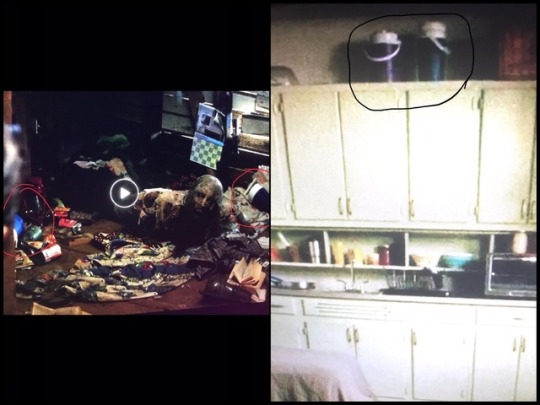
So how are the coolers tied to Beth, and why are they relevant to TD? See, the White Trash Brunch is a parallel to the Last Supper, but not the last supper from the Bible! The last supper from the Da Vinci Code, which is a different thing, and represents something else entirely. The plot of the Da Vinci Code is that Mary Magdalene and Jesus were married, they eventually had a child, and that child carried on the blood line through history and into present day. And the Holy Grail, rather than being a chalice, a drinking vessel, is Mary Magdalene herself, whose remains rests in a secret tomb below the inverted pyramid at the Louvre. I’ve explained the significance of the greenhouses/glasshouses in TWD in earlier posts. They parallel the secret tomb below the inverted glass pyramid at the Louvre, but I won’t go into that here.
The important part is that during the White Trash Brunch/The Last Supper, they drank “Frosty Cola”. Taste that name, it’s virtually antifreeze without the “anti”. When TPTB decided to name that soft drink “Frosty Cola”, they also signaled that everything that is associated with cold, frosty, freezing, cool, coolant, ice and so forth, points back to the White Trash Brunch/Last Supper. Antifreeze, coolers, fridges (remember Jessie’s fridge with the drawing of a blond girl and a car?)...And what’s the ultimate frosty freezing thing imaginable?
North!
The North Star, that always, without exception, points north (let’s not be too rigid and start discussing the difference between The True North and the magnetic North Pole, that’s for a different time). Remember how Beth stared at the polar bear blanket in 5x9 ”WHAWGO”. Also, remember how Beth in the deleted scene from “Still” explained how she always ended up with a can of soda instead of holding those red party cups. And remember how Carl explained to Judith that the North Star was the star to identify if you’re ever lost. And finally, remember how the North Star is at the end of the Little Dipper, and that Beth represents the Little Dipper through the spoon symbolism from “Still”.
@twdmusicboxmystery has made a wonderful edit to illustrate this point:
http://twdmusicboxmystery.tumblr.com/post/143078069994/little-dipper-td-bethgreene-bethgreenelives
So, take in this polar bear from Tyreese’s death hallucination for a second. Notice how it has a red scarf tied around it’s neck:
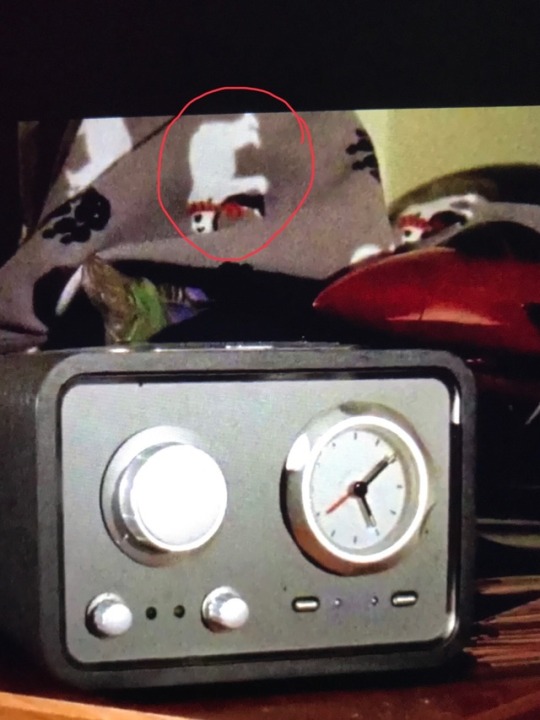
At this point, we need to discuss bears and bear symbolism. Let me explain! There has been a lot of bear references on the show, and they have a tendency to show up alongside other important Beth symbols. Check out @twdmusicboxmystery’s master post on bear symbolism:
http://twdmusicboxmystery.tumblr.com/post/171698126634/bear-symbolism-master-post
The reason for that is that in my opinion, bears are used as symbols of the Big Dipper and the Little Dipper, or the Greater Bear and the Lesser Bear. The first really significant Beth/bear connection was of course when she picked up the spoon in “Still”, the spoon representing the Little Dipper. The spoon scene, in combination with the scene where Carl talked to Judith about finding the North Star and how it’s located at the end of the Little Dipper, lay the foundation of the rest of the bear references on the show. Because even though Carl was technically right in his description of the North Star being located at the end of the Little Dipper, that’s not actually how you locate the North Star. I believe they wrote the scene like that solely to bring attention to the Little Dipper, and by doing so, connecting it to Beth’s spoon from “Still”.
That brings us to one of my absolute favorite things on the show; the Alaska license plate from 5x16 “Conquer”, that made Aaron the license plate collector so exited. At the time it seemed kind of random, but if you look closely at the license plate, you’ll discover that it has on it an illustration of the Big Dipper, as well as the North Star/Polaris. This is because the Alaska state flag includes this image, and I believe this is the reason why TPTB decided to include this particular license plate in the show. It functions as a way to illustrate how you really go about locating the North Star/Polaris. While the stars in the Little Dipper are faint and difficult to identify on the night sky, the stars of the Big Dipper are among the brightest stars on the night sky, making the Big Dipper one of the easiest constellations to identify. If you want to find the North Star, you first find the Big Dipper. Then you draw an imaginary line from the two stars at the edge of the ladle of the Dipper, and you’ll eventually find the North Star. The Alaska license plate illustrates exactly this, and that is the reason it was included in the episode.

And the reason that is so incredibly important for Beth’s story, is because locating the North Star is the first step of finding you way home when you’re lost. It’s canon, Carl said so! He told it to Judith, but Judith’s not going anywhere for a good while, that conversation was all about Beth.
Also, I can’t resist to mention Daryl’s choice of weapon in his fight with Justin in 9x2. A skillet!
It looks suspiciously like a super-big dipper to me. They could have given any weapon in the world, but they went for something that looks exactly like the Big Dipper.
The next time we encounter any significant North Star symbolism is in 7x2 “The Well”. The writing is literally on the wall in the Kingdom. We see Morgan pushing Carol in a wheelchair past some writings on the wall that reads “Hope is the North Star, let it guide you”. In part six I discussed how wheelchairs represent cars/tombs. Carol in the wheelchair parallels Beth in the car/tomb, but the North Star symbolism on the wall suggests that she made it out of the car/tomb, and will follow the North Star to find her way home. TPTB is blatantly encouraging us to let the North be our guide, and at the same time also emphasizing that the North Star represents hope. Hope is of course something we strongly associate with Beth, due to her “if you don’t have hope, then what’s the point of living” speech in 4x10 “Inmates”. Carol in the wheelchair symbolizes the tomb of Christ.
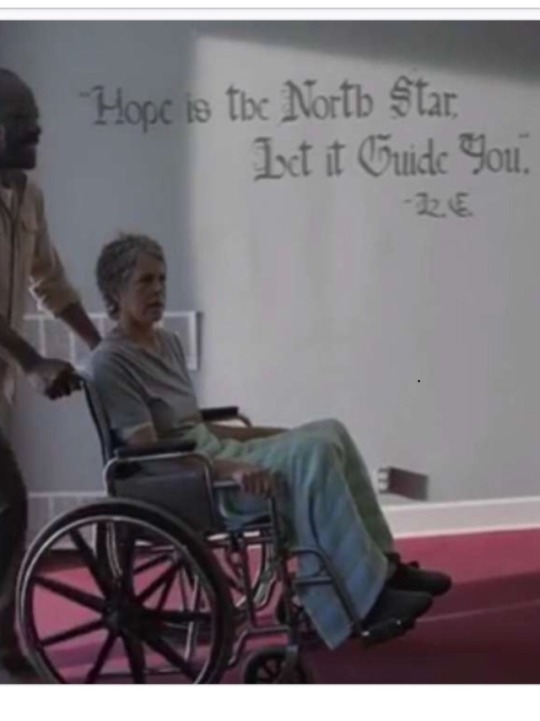
So! The North Star is located at the end of the Little Dipper, but to find it it will be far more useful to locate the Big Dipper. The Big Dipper consists of the seven brightest stars part of the constellation Ursa Major, which means Greater Bear. It goes under many different names. For those of you in the USA the name The Big Dipper will be most familiar, but in many countries in Europe it’s called “The Plough”. In Scandinavia it’s called “Karlsvogna” (referring to both “Carl’s wagon and “The Man wagon” Interestingly, in 9x1 “A New Beginning”, a plough and a wagon was given a considerable amount of screen time. For those who has read my previous metas on glasshouses with holes through the roof, you might recognize a familiar theme when Ezekiel went through the glass floor (which of course was the ceiling of the floor below, so it lines up perfectly with the glasshouse with holes through the roof theory). As he went through the glass he shouted “Save the plough!”, drawing even more attention to it, really emphasizing how important it was to save it. Now, consider the emphasis on the plough in relation to the fact that the Big Dipper (how you find the North Star) in many countries goes under the name the Plough. Consider how Ezekiel went through a glass floor while carrying the plough. How he shouted “Save it!” You might also have noticed that the wall in the downstairs area he fell into was covered in stars, confirming that there is indeed a star theme present. And ultimately, you might have noticed how a member of (the extended) TF had a close encounter with death but was saved at the last minute, much like we believe Beth was lost in a walker-related incident.
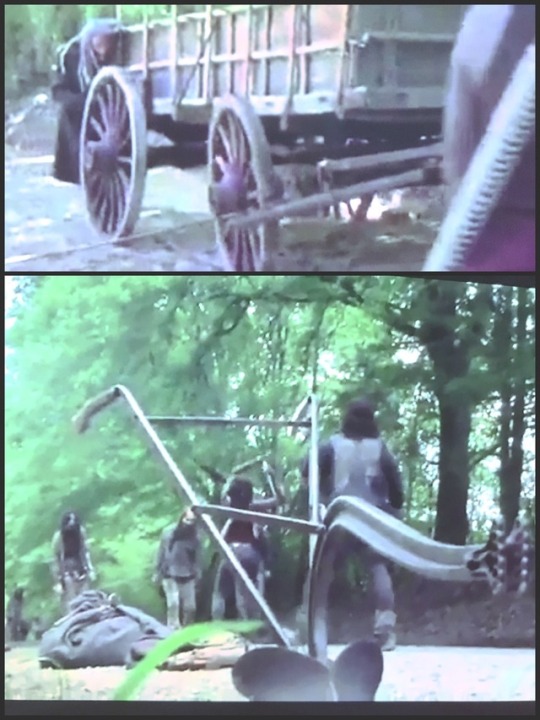
Later, when they were on their way home, they ran into unexpected difficultiesbecause a bridge had collapsed. I recommend reading up on the”Bridge” theme, here’s @twdmusicboxmystery’s master post on bridges:
http://twdmusicboxmystery.tumblr.com/post/175470337254/bridge-theory-master-post
They then encountered a horde, and lost one of their own, not by the walker bite, but rather from the kick from the horse that likely caused internal bleeding. If you’ve read part six of my Mary Magdalene theory you’ll remember how both feet and horses represent “The Body Of Christ”. Shoes are also a part of the “feet/foot” symbolism, and TPTB gave Ken a horseshoe mark on the chest and made sure it was in focus for several seconds, suggesting it has some symbolic meaning. I believe that the horseshoe mark on Ken was put there to remind us of that “The Body Of Christ” symbolism is still in play. This was further confirmed in that all of this took place next to a wagon and a plough.
And what do you know! The plough, (that represents the Big Dipper) got left behind!
I repeat; the plough, which is a different name for the Big Dipper, fell out of the wagon and got left behind! The plough represents the Big Dipper, which is how you identify the North Star. The wagon also actually represents the Big Dipper, as “Karlsvogna/Carl’s wagon” is also a different name for the Big Dipper. And a wagon is naturally symbolic of car/tomb. And I repeat, because this is important, the plough fell out of the wagon and got left behind!!!
(Judging by Maggie and Michonne’s dialogue in 9x2 they later retrieved the plough, but initially it was left behind)
So to summarize; saving the plough was of utmost importance. Ezekiel almost died for it! “The Plough” is a different name for the Big Dipper, and the Big Dipper is important because that’s how you actually locate the North Star on the night sky. The sole purpose of the Alaska license plate from 5x16 was to show how you find the North Star. And the North Star represents finding your way home! Beth finding her way home! Just like Carl explained to Judith in 6x10, and also remember how the writing on the wall in the Kingdom in 7x2 “The Well” encourages us to follow the North Star, to let it guide us, and to keep hope alive!
And now that we’ve established the importance of following North Star, I’d like to remind everyone of Ana’s severed leg in 4x4. She very obviously had a compass tattoo on her leg, TPTB was very diligent in making sure nobody missed that. They zoomed in on her tattoo multiple times, and we were to be very aware of her compass tattoo. Compasses point north.
Then, let me also remind everyone on the foot symbolism from the White Trash Brunch, how the pigs feet on the table established foot/feet as a Beth symbol, representing “The Body Of Christ”. Ana’s leg from 4x4 represents “the Body Of Christ”.
Then, we need to remember how Daryl drew attention to both the pigs feet and the Frosty Cola. All things frosty, freezing, cold, cool, coolers, coolants, polar bears represents something cold, and what could be colder than the actual north? This point is further emphasized in 4x13 “Alone”, when Sasha carries around a broken compass. Obviously this particular compass doesn’t point north because it’s broken, but Sasha stares at it, the camera focuses on it, and the next thing that happens is that we see Maggie “waking up” right next to an ice cream truck. It’s such a random sequence, it makes you think “how do they come up with this stuff”, but really, if you consider the symbolism of it all, it makes quite a lot of sense. They draw attention to the compass, it’s broken. It doesn’t point north. But then we immediately see an ice cream truck (ice cream? Cold. Represents north), and whatever the broken compass was missing in cold/north symbolism, the ice cream truck has plenty of it. And Maggie, who inexplicably decided it was a good idea to lay down to rest on the ground among the dead walkers, suddenly “comes to life”! She wakes up from the dead! North = coming back to life, find your way home after having been lost.
Now, consider again the compass on Ana’s leg. Compasses point north, always, without exception, much like the North Star always points north, always, without exception. The Frosty Cola from the White Trash Brunch represents “The Blood Of Christ”, which in turn makes Ana’s leg a combination of two major Beth symbols: the Body Of Christ and the Blood Of Christ. Feet symbolism and North symbolism in one.
And here’s the amazing part: there has actually been another incident on the show where TPTB utilizes the exact same symbolism!
Remember Boots? The mysterious figure that followed Rick and Aaron back to ASZ after their struggles to get to the food on the house boat on the walker-infested lake? Before I say anything else I want to really stress the fact that Boots followed the guys home! Boot = foot/feet symbolism, which means the Body Of Christ, which in turn represents Beth. We now know that Boots in reality was Tamiel, Jadis’ right hand, but for a while we only knew that character as “Boots”.
“Boots” had red and green wires wrapped around her ankle, and that is no accident. It is a direct callback to 4x4 “Indifference”, where Daryl explains to Bob how you start up a car. “Just use the red and green wires, it’s not rocket science”. Remember car represents the tomb of Christ as I explained in part six.
And of course, the image of “Boots” with the red and green wires around the leg is a perfect parallel to Ana’s leg with the compass tattoo. Because here’s the big thing: when TPTB chose to put such heavy emphasis on the compass, you could say that they in reality were focusing on the compass rose.
That means we can officially introduce rose symbolism into this mess, because behold! On Tamiel’s boot, what do we find, if not a compass rose!!! I believe that the Star thing on Tamiel’s boot is a compass rose! And Tamiel’s boot with the compass rose perfectly parallels Ana’s leg with the compass tattoo, and now I’d like to remind everyone that compasses point North, and following the North Star is how you find your way home, and the wonderful thing is that the compass rose on Tamiel’s boot followed Rick and Aaron home to ASZ!

And we know that’s not a coincidence, because later when Tamiel kidnapped Father Gabriel we got a shot of the back of the car driving away that was an exact parallel to when Beth were kidnapped by the Grady cops.
The compass rose on Tamiel’s boot is interesting, because we’ve actually seen it before. In 6x14 “Twice As Far”, we see a 16-pointed star on the wall in Edison’s Apothecary, where Denise, Daryl and Rosita are searching for antibiotics.
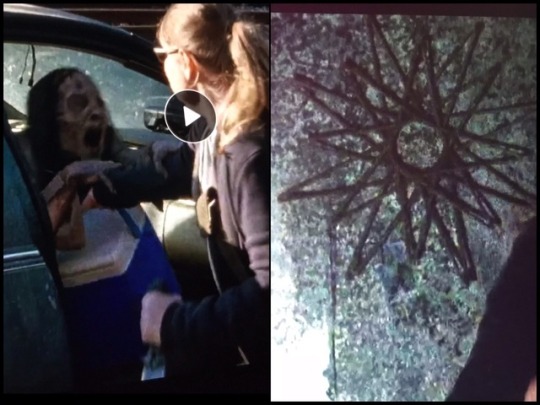
First of all, they were searching for antibiotics, it’s an exact parallel to 4x4 “Indifference”. Then Denise finds a keychain that she holds on to, the camera focuses on it quite a bit, much like in 4x4 when Bob finds a key with a screwdriver keychain. The camera focuses on it, makes us notice it. Then, as they are on their way home, Denise spots a blue cooler in a car. We know by now that coolers represents North/North Star/finding your way home/the “Blood Of Christ”. We also know that cars represents “The Tomb of Christ”.
Denise struggles to get to the cooler, she has to fight for her life to get to it, but she eventually kills the walker in the car, and is awarded with the exact can of soda she was searching for. Remember how Beth in the deleted scene from “Still” mentioned soda cans in the same sentence as the red party cups that represents resurrection. Denise overcoming her struggles and killing the walker in the car (tomb) represents Beth actually getting out of the car/tomb post-Coda. The fact that Denise later dies doesn’t change that, because that happens after she’s won over the walker. She escaped. Then something happened later, but she got herself out of the car situation. She got to the cooler, and got the can of soda. She lived.
But let’s return to the rose/star decoration on the wall, let’s return to the star on Tamiel’s boot. Remember how I in part one described how Abraham found a box of cigars in 6x6 “Always Accountable”. Remember how Tamiel put out a cigar in 7x16, while crouching behind some cars, the camera focusing on the star/rose on her boot, the star that I believe represents a compass rose. It’s a Body Of Christ/ Blood Of Christ symbolism combination, the boot representing the Body Of Christ, the compass rose represents the Blood of Christ through the cooler/coolant/Frosty Cola/North Star symbolism. And then the weird guy with the red umbrella walks by, the red umbrella representing Mary Magdalene and resurrection. It’s the same umbrella the Heapsters utilize to prevent the gates from opening, in an anti parallel to Ana’s leg keeping the gates from closing in 4x4. When TPTB chose to have Ana’s leg keeping the gate open, I think that’s symbolic of rolling away the stone that kept the tomb closed. It’s TPTB’s way of facilitating a hypothetical resurrection.
Now seems like a great time to talk about roses and rose symbolism. Of course when speaking of roses on TWD, one has got to mention the Cherokee Rose. We all remember the beautiful scene with Daryl and Carol, Daryl’s touching monologue about the Cherokee Rose legend. Daryl said that the rose was there to provide hope and strength, hope of finding missing loved ones, hope of finding Sophia. I find the “hope” part interesting because of the writing on the wall in the Kingdom.
Also, there’s the incident where Daryl spots a Cherokee Rose in 6x6 “Always Accountable”. He initially tried to escape from Dwight and the girls, however after realizing that he’d run off with Tina’s insulin he decides to return. The insulin container comes with specific instructions to keep it cold, which makes it a part of the cold/cool/frosty/ice cream/North/North Star symbolism. I also believe that the insulin is a pretty solid “Blood Of Christ” reference, as insulin is injectied in order to regulate blood sugar. Tina, who was basically unconscious at that point, “woke up”.
I believe that the North Star symbolism and the rose symbolism is one and the same. Remember Ana’s leg, with the compass (rose) tattoo. The markings on a compass, a map, a nautical chart etc. that indicates the cardinal directions as well as their intermediate points is called a compass rose. A compass rose usually have 4, 8, 16 or 32 points.
Remember how I initially mentioned that the TWD follows a template of The Da Vinci Code, rather than the Bible? In TDVC, Robert Langdon follows the Rose Line through Paris in order to locate the secret tomb of Mary Magdalene? In a TWD parallel to that, Daryl sees the Cherokee Rose, then decides to follow the rose and return the insulin to Tina. She was unconscious, but thanks to Daryl following “The Rose Line”, she gets the insulin and subsequently wakes up. The symbolism in that is significant. It’s a combination of the rose symbolism and the cold/frosty/North Star symbolism leading to a “resurrection” of sorts.
This is also the same episode where Abraham finds the box of cigars named “Dona Maria”, which is decorated with pink roses. That’s significant both because of the Cherokee Rose/North Star symbolism, but also because Tamiel later will come to act out a callback to this scene by putting out the cigar while the camera focuses on her boot with the compass rose. And for anyone who thinks the symbolism of putting out a cigar sounds scary and ominous, remember that the weird guy with the red umbrella walked by seconds later. Red represents resurrection. Red umbrella represents Mary Magdalene, who in Eastern Orthodox iconography often were depicted holding red Easter egg, representing the resurrection of Christ! To have Tamiel put out the cigar (while the camera focuses on the compass rose on her boot), and then have the red umbrella appear seconds later sort of parallels the Suicide Gang scene from 4x4. Just as the act of suicide is canceled out by the red cups they were drinking out of, Tamiel’s act of “putting out the light” is canceled out by the red umbrella that represents resurrection. And the “Antifreeze” from 4x4 without the “Anti” represents freeze/frosty/ice cream/North Star, just like the compass rose on Tamiel’s boot represents north/North Star.
Finally, let me say a few words on alcohol in general, and beer in particular on TWD. Much has been said about how alcohol represents Beth. I agree with all the existing theories on that, and I’d like to offer my interpretation of alcohol as a symbol. I’ll later do a theory on the Sirius/Dog Star symbolism and how whenever they use the word “Serious” on this show, it is code for Sirius. I know it sounds absolutely ludicrous, but I’ve systematically gone through all the the episodes after 4x1 and out and checked. There is not one single instance of anyone using the word “serious” on TWD post season 4 that cannot be tied to some sort of Beth symbolism. I dare you to find an example, I promise you that it will be tied to Beth. I’ve checked. But I won’t get into that too much here, because it belongs in a different theory, and I’ll get back to it later. But one very bright anonymous reader of @twdmusicboxmystery suggested that just like the writers use “serious” as code for “Sirius”, perhaps they use “beer” for “bear”?
!!!!!!
And I thought THAT’S BRILLIANT WHY DIDN’T I THINK OF THAT?
And I went through every “bear” reference on the show (well, most of them), and it totally fits! As we know, “bear” represents the Big Dipper and the Little Dipper, or in bear terms; Greater Bear and Lesser Bear. And the North Star, as we know, is at the end of the Little Dipper/Lesser Bear.
Thank you to that very clever anon!
http://twdmusicboxmystery.tumblr.com/post/177659080279/im-thinking-beer-maybe-was-a-hint-that-actually
The beautiful part is that this connection was flat out CONFIRMED in the season 4 finale of Fear. Spoiler alert, I’ll now totally reveal what happened in the Fear season finale, stop reading if you don’t want to know.
First of all, the entire back half revolves around a character we don’t see much of, but in return we hear about him constantly; Polar Bear! I swear I’m not making this up. So in regards to Beth, we remember how she stared at a polar bear blanket in 5x10 “WHAWGO”. We’ve established that all things cold/frosty/freezing/Polaris polar bear/North Star on the show represents Beth. So, here, on Fear, is a character whose name is Polar Bear. Ok.
In an incredible parallel to the Antifreeze Suicide Gang from 4x4 “Indifference”, the “Team Family” of Fear were poisoned by Martha, the villain, who had put antifreeze in their drinking water. The antidote to antifreeze is ethanol, or to put it plainly; alcohol.
Luckily there was a truck filled with alcohol just outside the service station(!), so it seemed like they’d make it. But then walkers attacked, shooting ensued and unfortunately the ethanol truck got perforated with bullets and the ethanol leaked out.
Well that was all very unfortunate, but just when they seemed to be doomed, Morgan showed up with Jimbo’s beer truck! And there you have it. Antifreeze is poison, but without the “anti” it’s just freeze! Frosty! Ice cream! Coolers! Polar bear! North! North Star! Antifreeze is death, but if you take away the “anti” you get “freeze” which is life. It’s both stupid and wonderful all at once!
Get it? They drank beer, in Polar Bear’s service station. It saved their lives!!!
And we see that the ethanol theme continues in s9 of TWD. Apparently it is the Sancuary’s responsibility to provide ethanol fuel for the wehicles in all the communities, and it will be very interesting to follow that theme going forward.
14 notes
·
View notes
Note
((thanks a bunch for extending the fic requests!)) could you write something really angsty like kak coming back home and having to explain to his parents? thanks! :)))
(Hey, sorry about taking so long on this!!! Hopefully this was worth the wait.. ;; I decided to do something a little different, and have this entirely from his mother’s POV instead of kakyoin’s. I hope you enjoy though! Link to the ao3 is in the title)
Vanishing Act
The cherry blossoms would come into bloom soon.
The days seemed to go by ever more quickly, sun up then the slow streaking of the sun across the sky then sunset, repeating again with the rise and crest and fall of the moon in passing waves and pulses of light. The chill wasn’t so bad anymore. Perhaps there would be an early night parade, her husband had fancifully told her, as if any of them still had the energy to get swept up in those sorts of stories. The old man could talk about yokai and inverted days and strange occurrences all he wanted- he’d stopped looking.
Her husband had stopped looking. As did the police, the search parties- no one searched for her son. He was a runaway, they said. He’d been kidnapped, others claimed. He’d be better left for dead.
But Masako hadn’t stopped.
One hundred days ago, Noriaki went missing.
It was getting close to dusk. Even with the days lengthening, things still dimmed early on, and the chill bit at her ankles as she made her way again through the town, taking route five of the thirteen separate rounds she’d taken upon herself. She may have given up on posters- if anyone had seen Noriaki around the city, it would have been impossible not to find a place where she hadn’t plastered their contact information. It was very likely that he wasn’t even in this city- but still, she walked the same paths anyway. Even if she wouldn’t find Noriaki, there was a certain… well, not peace. But it took her mind off of things.
Masako passed by an alleyway, feeling a dry wind come her way and threaten to blow the ties holding her hair back into the concrete wilds. There were plenty of places where she’d felt such drafts- the cers, blowing with nearly enough force to rival that toppling Mistral wind of Marseilles, blowing her back into her husband’s arms and then again nearly into the Mediterranean; the Foehn in the Alps, seeming to melt snow right before any weary traveler’s eyes; the winds during a particularly hot day in Cairo, on the last trip they’d gotten to go on together. The wind blew again and it gave her pause, as she watched it whip past her and rustle fallen litter and jostle whatever rusty scraps were in its way, racing off to try and carry them around the world on its lonesome.
“Perhaps he was whisked away,” Her husband had said, trying hard to be lighthearted and whimsical but sounding more sorrowful than anything. She understood why- she used to love those stories. He was trying to be strong, but she was already strong for the both of them. “by the night parade? Any yokai would love to whisk away a small bit of sunshine for themselves during such a horrid winter…”
Perhaps he’d been whisked away- it was certainly something that had crossed their minds, and it had kept her awake at night, trying not to imagine some terrible beast laying a hand on her son- or trying to do worse to him. Every single scenario that had passed through her mind was too terrible to name, and every rewind and rerun of the possibilities grew more and more mutations, adding a layer of infection that she could sometimes feel on the surface of her skin.
She continued walking forwards, eyes sweeping across the slowly narrowing path of the sidestreet she was on. Masako knew this part of town wasn’t exactly the sort that a seemingly feeble woman pushing her mid sixties should be walking down- she’d grown up alongside streets just like this one, back when the war had hit and back when the Americans had come, and through the subsequent decades. They were streets she’d tried her best to make sure her son didn’t have to walk down.
And they were streets that held jeers from between the margins, countless old faces staring out at her like ghosts. They were simply remembered- the face of an American soldier who’d tried to make her his bride, an young beaming blond with a simple demeanor and a gap in his front teeth. An old boss, seedy to the point where every pore of his skin was strawberry like, but who was kind to children and had a soft spot for old women, back when she worked. Old women, now dead, who started up rumors during the war effort that her hair became red because of grotesque stains she spilled behind closed doors- girls who wondered if she was an antique doll the few times she was able to get away with more traditional dress in public and who asked her for secrets about times before- countless whispers from countless travels in thirty or so tongues, twenty-five of which she knew sparingly and five she was intimate with herself.
But none of the faces were her son’s.
She found herself on the main road, looping back around towards the house again.
There was laundry to be done. Her husband usually wrote about this time, or read the newspaper and complained to her about the bizarre adventures he could never seem to capture. She’d promised tonkatsu, but what was sorely needed was a good hotpot. It wasn’t often she was nostalgic about when she was a girl, but she thought of anglerfish nabe- too much stigma around catching those nowadays…
She hadn’t made it for Noriaki, yet. Anglerfish was rarely caught, and now expensive. He would’ve at least loved trying it- it was the sort of oddity her son had been habitually drawn to.
That her son is drawn to.
He isn’t dead.
She felt that deep in her heart- he wasn’t dead. Not her Noriaki. Not her little miracle, the tiny babe who they said would never make it and who’d grown into such a fine young man. Not the strange, quiet child who laughed in the face of what made others fearful with a sunshine delight.
He had a certain fighting spirit- one that couldn’t be quenched even after one hundred chilly moons had passed.
She would find him soon.
She would.
She walked to the front steps of their rich house. Masako had been able to afford it with her husband, as they had both worked, since for the longest time there was no child for her to raise. She was traditional, in many respects- it was one of the few things that kept her afloat when the war passed and Papa died in the Pacific, when the Americans had come and turned their way of life inside out to try and gore their identities now that they’d gorged themselves on enough lives taken then gored their skulls to boot. In all else, it was what she enjoyed most- the routine of making house and motherhood, of telling stories to and playing with Noriaki as he toddled around the house and watched shadows when there seemed to be none.
She dreaded coming home to this, now. It was large. Luxurious. The years of hard work, of learning and striving to better herself, paid off. It reminded her of vacations in a hundred and one cities and experiences and teaching, always teaching and guiding her son around. He’d had trouble with making friends, so she tried to be his friend as well as his mother, and then tried make the world his friend as well. Any chance to open it up to him- any opportunity to give him everything she had only dreamed of as a child- all started here.
Masako had known that she would have an empty nest soon. She’d come to terms with college and new avenues, of tours around the world without her and with infinitely more quiet days without the gentle tap of Noriaki moving around the house, or his occasionally helping with chores she didn’t need assistance with in the first place, or the excitable sounds of whatever virtual console or sumo match he would privately be excited for drifting from the living room.
Walking inside a house she expected to be silent, Masako heard something that gave her pause. Low hushed whispers in the living room gave way to the habitual silence that she was expecting, and she quickly gathered herself, eyes narrowing. Had someone broken in? There was an iron poker somewhere in this hall if needed….
There were a couple more whispers that wafted out as she crept forward, before they were cut through by a deep, gravelly voice that blankly said, “Give me a break… Just go already.”
There was silence, and then the sound of someone heavily getting to their feet. Shuffling, and the sound of something dragging, and then, the paper door to the living room slid open. There was a little snag, that the screen tended to hit if one didn’t know about it- since this house had been one of those stately Western-style affairs that rich ladies bought up once upon a time, complete with drawing rooms and parlors, all having been remodeled to suit her and her husband’s tastes, but they never did get the installation of that one screen right- but she didn’t hear the snag hit. Her husband, then-?
“… Hello, mother.”
Her heart skipped a beat suddenly, and in front of her, there was her son.
For a moment, she was cowed into silence- he was still as big and tall as ever, an inch taller than his father and a head and half taller than her. His hair was done in that style he liked, still red- eyes still the same too.
But it was all so different as well, and not just because of the crutches he clung onto for dear life or the scars that now adorned his eyes. His shoulders had wilted a little, though his chin was up, lips pressed tight together in a more secretive array. There was more burden on him than just the stoop of his posture now, more than even when he’d been growing up and saying strange, cryptic things, reminding her of changelings and spirit children and whatever other whimsical nostalgia she’d surrendered herself to.
The world had not been kind to her son.
Still, Masako had to steady herself against one of the side tables against the wall, feeling faint as the gravity of the situation pulled down on her eyes. She covered her mouth as the tears finally began to roll.
“Ah-!” Noriaki tried to move forward quickly, and now she could see through her blurred eyes that his steps were almost as shaky as a faun’s- weakened. Atrophied. Broken? How many times? How many times had she faced the thought of the worst, of her son being maimed and brutalized in any conceivable way with no way to help himself and no one to help him? He still kept somewhat of a distance, hands hovering slightly as if trying to figure out what to do. “No, don’t cry, please-”
“Oh, my son…” Masako moaned through her sluggish tears, “Noriaki, what happened to you? Who would do such a thing… Why were you gone? Were you taken-? Or… did we do something….” To make you run.
For once, it wasn’t she who attempted to initiate any affection- she’d learned early on that hugs and hand holding and other such coddling simply wasn’t something Noriaki enjoyed too much, so she was polite and tried to ask before invading any boundaries- it was her son. He finally moved forwards, letting one crutch fall to the ground as he tried to pull her in for an awkward little hug. It was only then when she realized that his hands were shaking.
In a tight voice, Noriaki told her, “I’m sorry.”
“I’m just glad you’re home.” She whispered.
For a moment, he allowed her to stay like that, pressing tight against him and crying, forgetting herself and any number of manners in the visceral relief of knowing that finally, finally, he was home. One hundred days gone, and if one day more had passed she might have had to take him for dead- no matter the effect it would have on her old heart.
Finally, she managed to find her composure again. She finally pulled back, pulling a handkerchief from her pocket to delicately dab at her eyes so that she could fall back into the old pattern and routine that was herself. Taking a breath, and then another for good measure, she managed to smile somewhat at Noriaki, already bending down to pick up his fallen crutch. A little normalcy was in order, in the face of this- if only to help process everything. “Now then- you have a guest. Has your father brought tea?”
“He hasn’t-”
“Then do you mind entertaining your guest and your father while I bring some some out?” Masako smoothed out the edges of her shirt, letting out a breath. It had been an emotional one hundred days, and she’d let her feelings get the best of her- and there was still more emotion to come, she was sure. The least she could do was provide something to eat so that no one’s energy ended up depleted by the time this draining talk would end. Besides, making a tray would help clear her mind. “We have… much to talk about.”
“We do.” Noriaki acknowledged, though he didn’t seem too enthused about it. Neither was she, truth be told, but the both of them would simply have to smile and bear it. Like they do with most talks- even if this talk was of the misery that had seized this household. “… I’ll tell Jotaro that we may be here a while yet.”
“Thank you. I’ll be sure to properly welcome him then- and Noriaki?” She looked over him, “Don’t strain yourself.”
“I’ll be fine, don’t worry. I’ve only been standing for a bit-”
Masako repeated, looking up at him, “Don’t strain yourself.”
There was a quiet moment before Noriaki lowered his gaze politely, head bowing slightly, “Yes, mother.”
She beamed, and then moved past him to go to the kitchen.
They still had jade drop tea- an expensive gift given from a friend who regularly visited, to try and ease off the pain with distraction. She finally opened it, and was able to finally make it, filling a teapot she’d gotten in Morocco with the stuff and setting aside some yōkan as well. It was a normal gesture- and it almost felt surreal, being able to do bring in the tray and still see her son there, sitting down and not straining himself. Thankfully.
The one beside him was dark and looked annoyed, taking up half the couch with his size. Despite looking to be a man in physique at first glance, his face still betrayed boyish indications and his countenance was of any adolescent in a vaguely uncomfortable situation. Masako lowered her eyes merely out of courtesy and set the tea tray down, speaking softly, in a controlled way so as to not rudely burden their guest with the full brunt of her rather harried state as of the moment, “Welcome- my name is Kakyoin Masako. I do hope that you’re comfortable.”
The teenager nodded, and Masako started pouring tea. “Now then- if I may be so bold, may I ask what has been discussed so far?”
“As if one could stop you from being so bold.” said her husband somewhat humorously, a wry smile playing on his lips. His eyes had long since sunken in from sleepless nights- though thankfully, he was able to steal some precious slumber time at work.
“Talked about what you’ve been doing.” Noriaki’s guest- Jotaro, a rather grave boy, even at his age- said plainly. Straight to the point- Masako appreciated that. “About your thirteen routes.”
“Unfortunately today I only had time for the one- I was a little preoccupied because I thought I saw anglerfish on sale someplace.” She said cordially, acknowledging that it would only make sense to wonder where she’d gone. “And have you said anything about the extent of your condition, Noriaki?”
“No…” Masako laid the mugs out, calm even as her fingers shook a little- out of anger, out of despair, out of fear for the extent of what she didn’t know. The only reason none of the tea dripped and her long sleeves remained free of any stain was years of practice. “There’s… a lot to discuss, and it won’t make sense without context.”
“Well, that is the point of a discussion, is it not?” Masako said easily, tilting her head.
“I would suppose that the point of a discussion is communication.” Noriaki said back, and Masako’s eyes narrowed. She knew stalling when she saw it- her son wouldn’t get away with beating around the bush here. Not in this house.
“Communication of contexts, dear. Everything must be understood in context, so how shall we communicate if you give us none?” She glanced at Jotaro, softening the blow with seeming indifference and quick passing into polite deference so that Noriaki would have no time to get a word in edgewise. Flighty though it may seem, it was always effective. “Would you like some yōkan, then?”
“I don’t eat sweets.” Jotaro replied gruffly, simply watching the proceedings. Smart- it was good to know when and when not to speak.
“Pity… but in any case, then, that leaves more room for you to tell us what happened.” She turned to Noriaki, who looked calm on the outside but who’s eyes habitually drifted towards the door. “Noriaki… where were you all this time?”
“I…” He sighed, and then finally, began speaking. “I ran away with four other men to travel across the world to help save Jotaro’s mother’s life.”
“How noble of you.” Masako said gently, then said, “Is that why you didn’t tell us? Because of what I assume to be a dangerous venture, or because that nobility seemed a little less great if you were to have permission first?”
“… No.” Noriaki said as Masako took a sip of tea. “Listen- this is the part where context may seem rather… outlandish.”
“No more outlandish than most things I’ve heard being said at the office.” Her husband quipped a bit, trying to lighten the tense mood being masqueraded.
“… Right…” Noriaki said, eyes sliding back to his mother. “Do you remember the… imaginary friend I had?”
“Yes.” Masako said, giving a tight smile.
“Well… it… has to do with that.”
“Ah, so did this friend of yours convince you to join the night parade.” Masako said rather flatly.
“The- actually.” Noriaki said, sighing. “I’ll just demonstrate. After all, it’s rather helpful, and you did say not to strain myself.”
“That I did.” Masako confirmed, and Jotaro looked between the both of them, eyebrows raising.
She was about to ask how those injuries came about in the first place, but the words came to a screeching halt. Suddenly, the tea cup in front of Noriaki began to float. Just. On its own, as if it were a casual everyday occurrence. The cup came into Noriaki’s grip, and he took a calm sip, posture even more stiff than before. His back was straightened up though, at least, and his companion watched in vaguely amused silence, eyes following something that Masako for the life of her couldn’t know.
“That was my imaginary friend.” Noriaki said, looking a little smug, but honestly Masako couldn’t blame him after that entire magic trick he’s just pulled off. Masako didn’t know what to say, and if she said anything, it would have come out gobsmacked and stuttering, so she said nothing. She simply took another long sip of tea. Her husband’s mug dropped from his hands in shock, only to be caught by the invisible force and gently placing it back into his hands.
Both of the teenagers in front of them seemed slightly uncomfortable, silence coming to them as well. Masako could have denied that this was real- but that was the coping mechanism of a coward with a disdain for reality, and truth could be stranger than fiction. She could have also trembled, or screamed, or any number of things that many other people would have done, but at this point- after her son had disappeared, after all these years of seeing his odd development, after all the events in her own life, it was far easier to remove herself from the emotion of the situation first and observe before assigning them the emotion due to it.
Making sure that she was suitably numb to it for the moment, Masako said simply, “I see.”
“… That’s it?” Noriaki said, face twisting in disbelief. “Just… that? That’s all? You didn’t see for the past seventeen years…”
“Actually,” Masako said, as calmly as possible, “I’m very close to fainting at the moment. You’re psychic.”
“Not quite.” said Jotaro, just as calm but seemingly a little more at home. “We actually have ghosts that come because of fighting spirit that only we can see.”
“We or… other stand users. They’re called stands.” Noriaki finally said, relief setting into the dip of his shoulders. He shifted, and then winced. “We went on a trip around the world due to these stands, and I… rather liked it.”
“There’s no shame in liking a trip- though I don’t understand why you’d like one that left you…”
“… like this.” Noriaki let out a breath. “If it helps- this isn’t forever. I’ll be able to walk soon. But… I will need medications for the rest of my life. And I may need more surgeries, depending on how my… new spine is.” He shifted, visibly pained, and Masako felt her heart twist in her chest. “My vision won’t be the same either, but there’s no… guarantee that it won’t get worse, one day. It will come at great cost, and I do have a way to pay for expenses-”
“Nonsense.” Her husband said, and Masako let him take over for a bit, simply watching. Noriaki gently gravitated to Jotaro’s side, and Masako observed this. “You know for a fact that expense is of no concern to us, Noriaki- nor room, board, and access to whatever help and therapy you need. So let’s stop with that sort of talk. I’m rather interested in your new friend-” He finally turned his attention to Jotaro, eyes shining a little. “I do hope Noriaki didn’t give you grief- when he wants to be, he can be quite the chatterbox-”
“Hold on just a moment-!” Noriaki tried to say.
“Ever since he could first talk-”
“Do we really need to do this…?” He looked to Masako, who took a final sip of tea, looking him dead in the eye and saying not a word. This was his punishment- mostly because Masako didn’t have the heart to do anything as harsh as grounding him or the like. He’d been through enough already. But that didn’t mean that he couldn’t handle a little embarrassment in front of that friend of his.
She smiled, despite it all. There was still much to process- still a lot of questions that she had, but for now, she knew to keep quiet. Noriaki had been interrogated enough for one evening, and now was the time to relax and celebrate.
“I’ll bring some more tea.” She said politely.
Her son was home.
#fanfiction#jjba#noriaki kakyoin#jotaro kujo#hierophant green#jojo's bizarre adventure#jojo no kimyou na bouken
50 notes
·
View notes
Note
Oh! Do any of the other characters' names have some form of meaning?
Yes!
Simone is a form of Simeon, which means “one who hears” in Hebrew. This fits into the way her subconscious filters information and memories into hallucinations to reveal important observations to her conscious mind.
Leif means “heir” or “descendant”. As he is determined to be the last Valstad to have carried the traditions of his bloodline, this will make him the final heir to that brutal path.
Bjørn means “bear”, which I chose for its association with hibernation, and as a joke because he was a rather petite man. The importance of hibernation in this context refers to the dormancy that takes place upon his death, a dormancy that has ended since Leif has inherited his legacy in Ouroboros.
Henrik means “ruler of his household”, which is what he had to become when Leif was taken to the USA. He had to quickly become the father figure to his two younger siblings, which leads us to Vidar.
Vidar’s name comes from Norse mythology. “Víðarr“, as the myth goes, is set to avenge his father’s death at the end of the world. Vidar does the quite the opposite, inverting the myth and betraying his own name.
Onto their actual father, Einar is derived from the concept of einherjar, or warriors who had died in battle to ascend to Valhalla. His death sets the events that will “ascend” Leif into his “divine” status in the cult into motion.
Anders is derived from the Greek Andreas, meaning “manly”. He becomes obsessed with becoming the quintessential man in Simone’s life, and the more comfortable he is with that taboo, the more of his identity is lost to those flawed masculine ideals. His character throughout CtD is quite literally reduced to what he can be for her as a man.
Bonus: Agent Maier’s first name is Dick, but not for Richard. He had a very terrible life before he was taken into the foster care system after the “mysterious” fire that killed his family. He doesn’t like to be touched now.
1 note
·
View note
Note
Hi Clockie, what are your expectations, hopes and fear for Voltron season 4? In general, and Lotor-related? Have a good day!
Here’s my personal list! (I’d appreciate if no reblogs try and “extend” the list by just adding more points to it; if you want to just make your own list please do so in a separate post)
Expectations:
The situation for Lotor is going to get very tense.
Zarkon, in some magnitude, resuming power and moving back into play- we don’t know how much yet. Either way, pretty likely causing the above.
The paladins are going to catch on more that the galra are not currently a unified front- that Lotor is operating separately from, if not actively against, his father.
Whatever resolution/exploration on “Kuron” occurs, it will continue to treat the Shiro we encountered/followed in s3e5 sympathetically.
Hopes:
Backstory for the generals.
Acxa and another general potentially returning a favor to Keith after s2e9.
Queen Merla
Romelle
Lotor and Allura being half-siblings because of genetic experimentation by Zarkon/Haggar.
The fandom chilling out about Shiro’s haircut.
Haggar stepping up for the big season finale brawl, inverting their positions in the s1 finale where Zarkon took center stage and Haggar was running support- having Haggar, instead, be the main antagonist for the s4 finale.
Keith and Acxa being siblings.
More of that premium quality softcore cosmic horror vibe this show has been steadily accumulating.
The Lion Swap being completed by Shiro taking up the position Allura vacated and flying the castleship, potentially with a new/upgraded prosthetic. Since, it seems like they’re not gonna go back to standard formation quite so soon, and it doesn’t make sense to put so much importance on Allura’s position in earlier seasons only to make her the one person whose absence from her prior role isn’t felt.Also look me dead in the eye and telling me Shiro wouldn’t find opening on Zarkon with all of the castle’s weapons at once intensely cathartic.
Coran taking up a weapon and fighting on foot.
Fears:
Kolivan dying; more named Blade members dying.
If clone theory is true or there are somehow multiple versions of Shiro, one of them dying. Especially if the survivor has to watch it happen. Double especially if it is not clarified which Shiro was original because I think Shiro has enough survivor’s guilt and identity problems.
The Keith/Acxa sibling theory being shot down.
Things I’m simultaneously excited for the prospect of but also I’m not remotely emotionally prepared for and will probably absolutely destroy me:
Things going downhill for Lotor and the generals and seeing a more obviously vulnerable side from them. All of these kids read as carrying bad histories and it is gonna hurt.
Coran. Listen. Listen, I did not watch ATLA for nothing, Coran is 400% another Iroh, we’ve had our moments already but this guy’s GoLion counterpart canonically lost his wife and infant son and in VLD he’s talked about how he can’t lose Allura “as well”. I don’t know where, I don’t know when, but at some point Coran is going to destroy our souls. Probably more than once.
#voltron legendary defender#vld#long post /#the fears section is really short because I pretty much limited to things I actually think are likely to happen#Anonymous
154 notes
·
View notes
Text
MAYA WORLD (1200 BC-1200 AD)
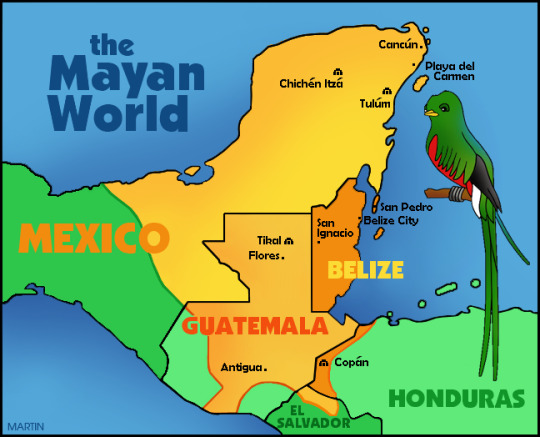
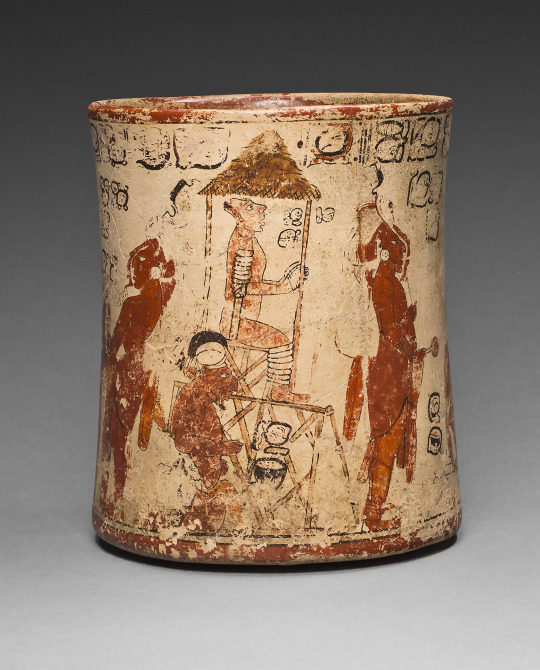
Vessel Depicting a Sacrificial Ceremony for a Royal Accession (650-800 CE)
September 25, 753 AD
This vessel, used to consume a chocolate drink, depicts a key event in a royal Maya accession ceremony, which shows the relationship between human sacrifice and the assumption of power. The expectant king is flanked by servants, musicians, and masked nobles, while a terrified captive—bound to a scaffold—awaits his death.
It is probable that the victim was a warrior from a rival community defeated by the prospective king during a coronation war. Such sacrifices were required as proof of a new ruler’s military abilities, provided an offering to his patron gods, and served as a sign of the triumphant reign to follow.

Vessel of the Dancing Lords (750-800 CE) Guatemala
According to ancient Maya belief, after several failed attempts the gods succeeded in populating the earth when they created humanity out of maize, the staff of life.
In the Popol Vuh, a sixteenth-century epic of the K’iche’ Maya, the death and resur¬rection of the maize god was likened to seed corn that sprouted and produced new life.
This vessel from the Late Classic period (600–800) depicts a Maya ruler attired as the maize god in three almost-identical panels. On his back, the ruler wears an enormous rack containing brilliant feathers, heraldic beasts, and related emblems. Just as maize plants sway to and fro, the maize god dances to the rhythm of life—often, as seen here, in the company of a dwarf.
Among the Maya, dwarfs were seen as special beings with powerful spiritual connections to the earth and the interior world below.
This vase refers to a rite of passage in which dwarfs assist the soul of the deceased into the domain of the dead, from which it would eventually be reborn in the royal lineage, just as maize sprouts again in the cycle of nature’s renewal.
This vase of the Dancing Lords may have been painted as a funerary offering for a noblewoman with dynastic connections in the city of Naranjo, where it was made.
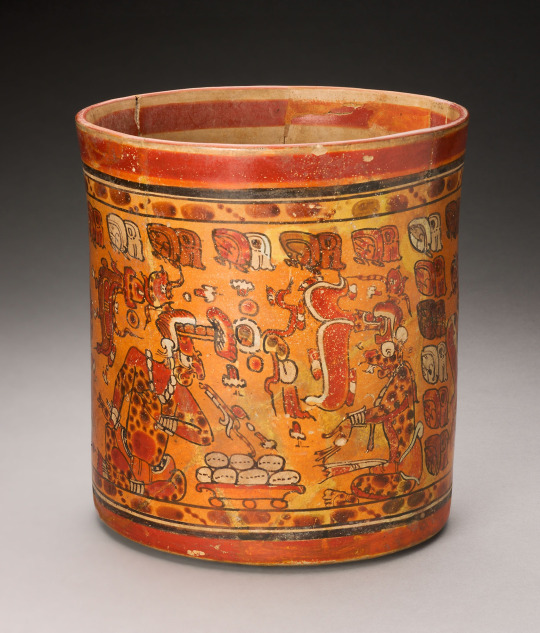
Vessel Depicting K’awiil (God K) and Itzamna Exchanging Gifts, (700/800 CE)
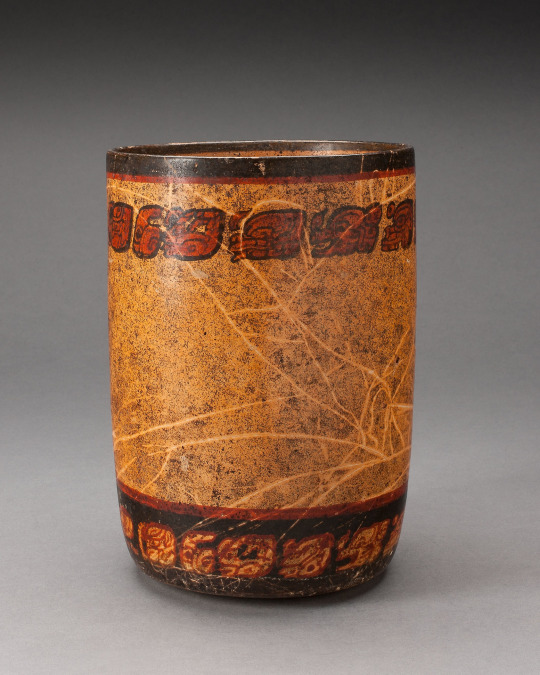
Cylindrical Vessel (250-900 CE)
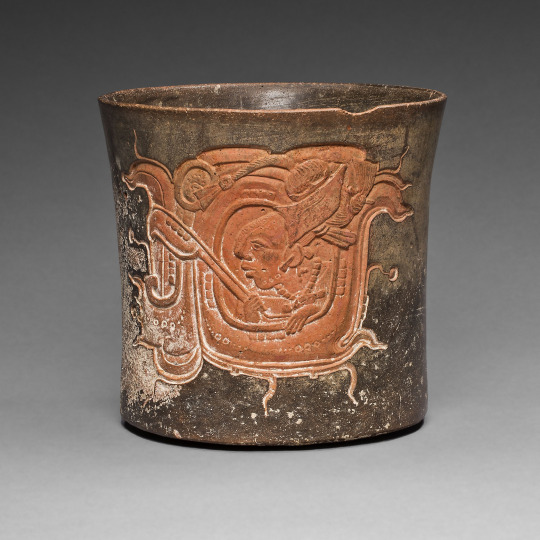
Carved Vessel Depicting a Lord Wearing a Water-Lily Headdress, (600/800 CE) holding a water paddle and left hand resting meaning.

Vessel Depicting a Mythological Scene (600-800 CE)
A God holding a conch shell, black markings indicating God status, and turtle below, the earth above the sacred waters. Aj Maxam is the artist.
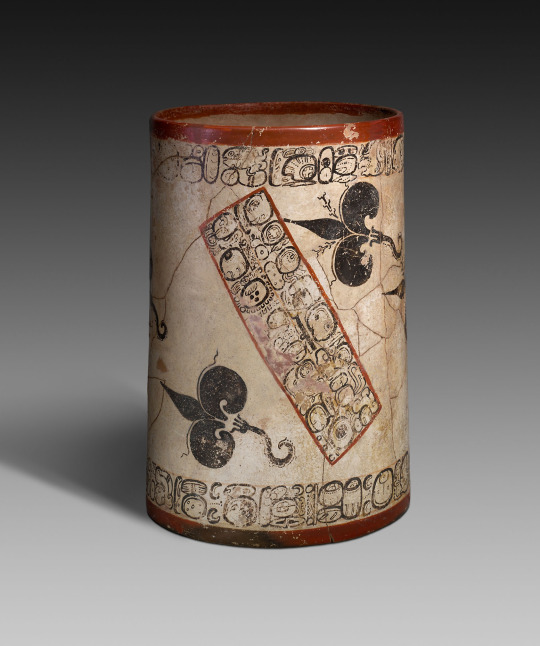
Water-Lily Vessel (750-800 CE)
The simple, elegant design of this vessel reflects the refined abilities of the artist, who painted images of water lilies and a hieroglyphic text with a perfectly controlled brush. The inscription below was the first to be deciphered on a Classic Maya vessel. It states the name of the artist, Ah Maxam (aj maxam), and declares that he is a member of the royal lineage of the kingdom of Naranjo. His mother and father are also named on this vessel, as well as on other dynastic monuments from the region. For the Maya, water lilies were symbolic of the watery surface of the Underworld and the earth’s regenerative powers.
The water world before human creation
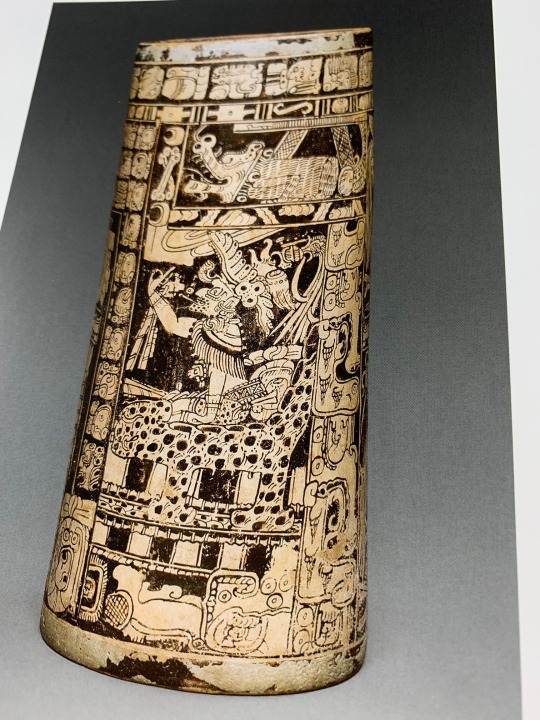
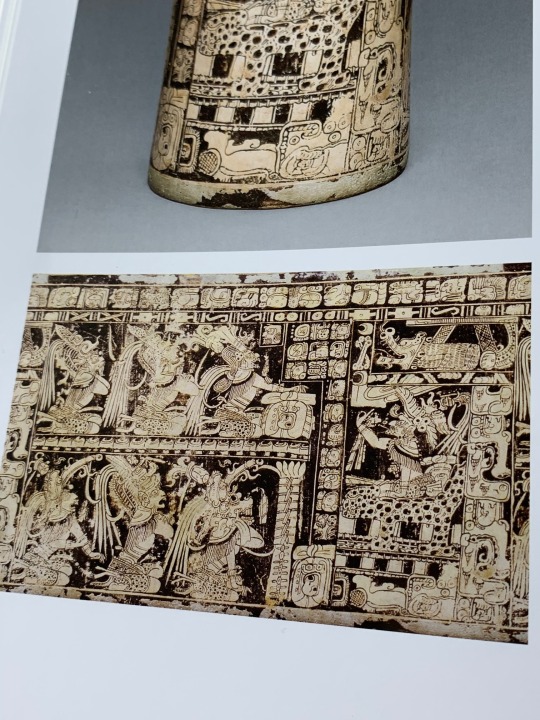
The Vessel of the Seven Gods
God L, Lord of the Underworld,, Jaguar pelt throne
August 13, 3114 BC panel, God L assembles the Gods, the Maize God emerges

Vase Depicting a Courtly Scene (600-800 CE)
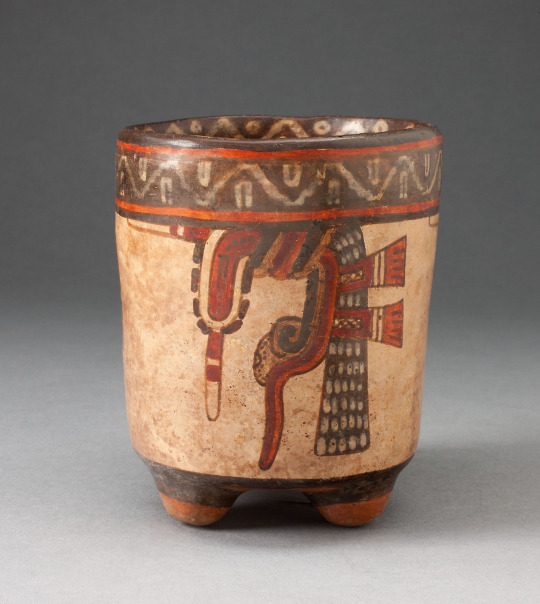
Tripod with Knotted Motif (850/950 CE)
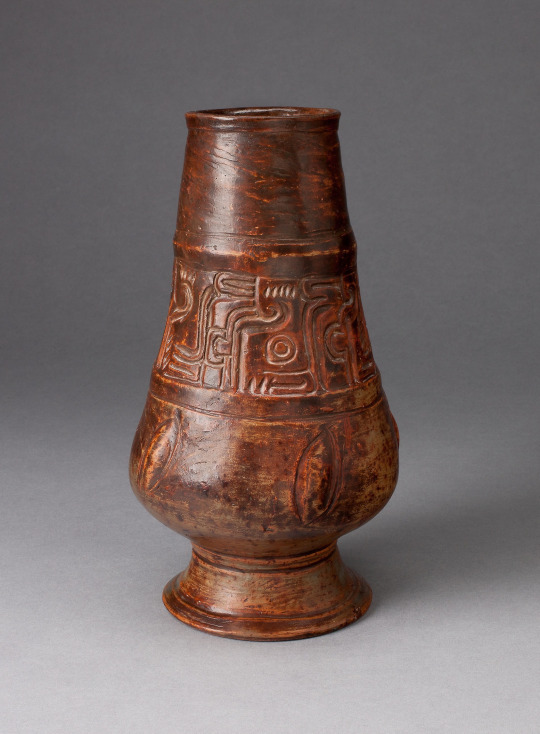
Footed Jar Incised with Pseudo-Gylphs (250/600 CE)
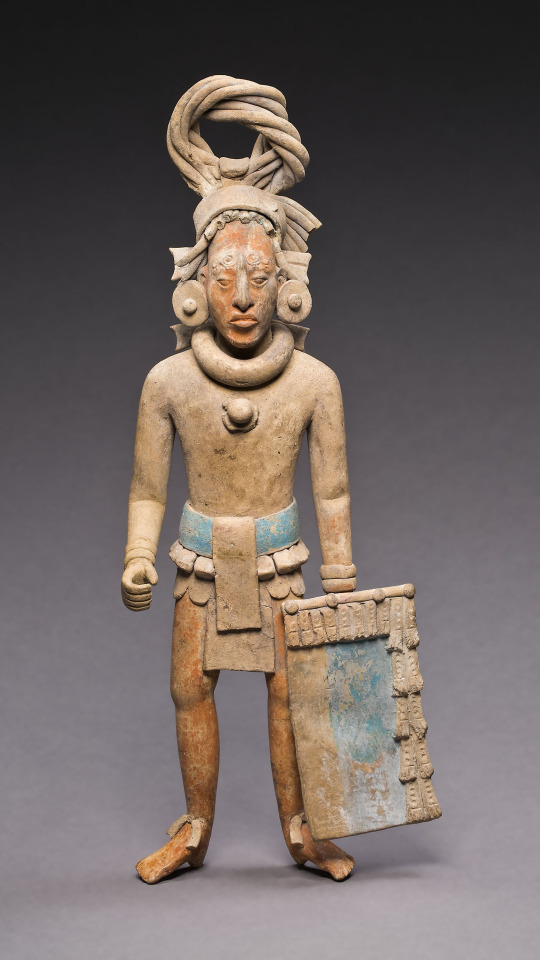
Figure of a Standing Warrior (650/800 CE)
Jaina
The costume and equipment of this figure indicate that he represents a warrior. He carries a rectangular shield and a long wooden spear (now lost), and the detailed attention given to the intricate headdress and facial features—marked by scarification, tattoos, and paint—suggests the portrait of a specific military commander.
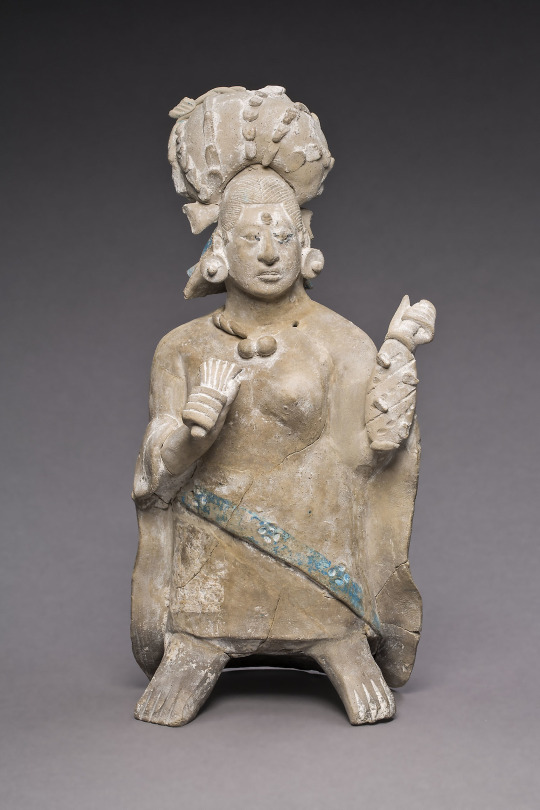
Figure of an Aristocratic Lady (650/800)
Jaina
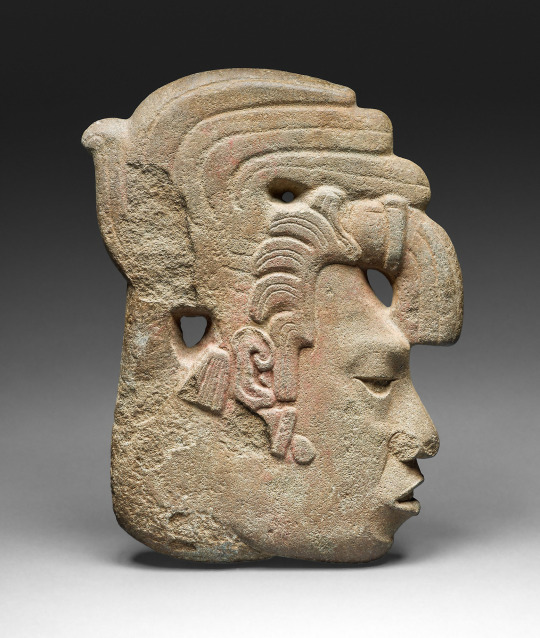
Royal Profile (650/800)
Ball Game Hacha, Maize God
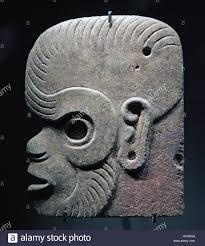
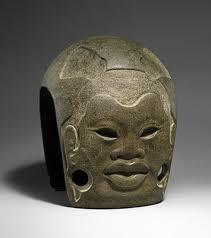
PALMAS
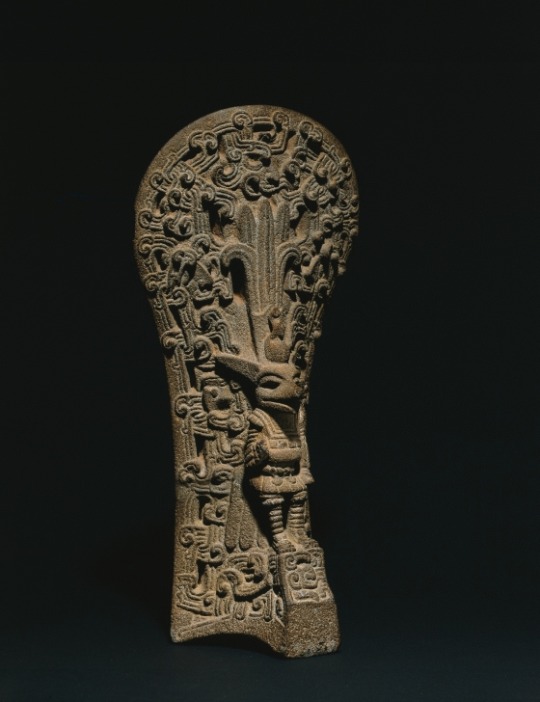
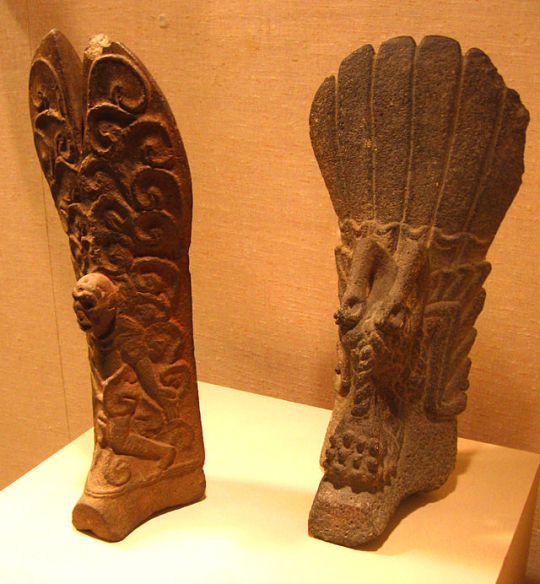
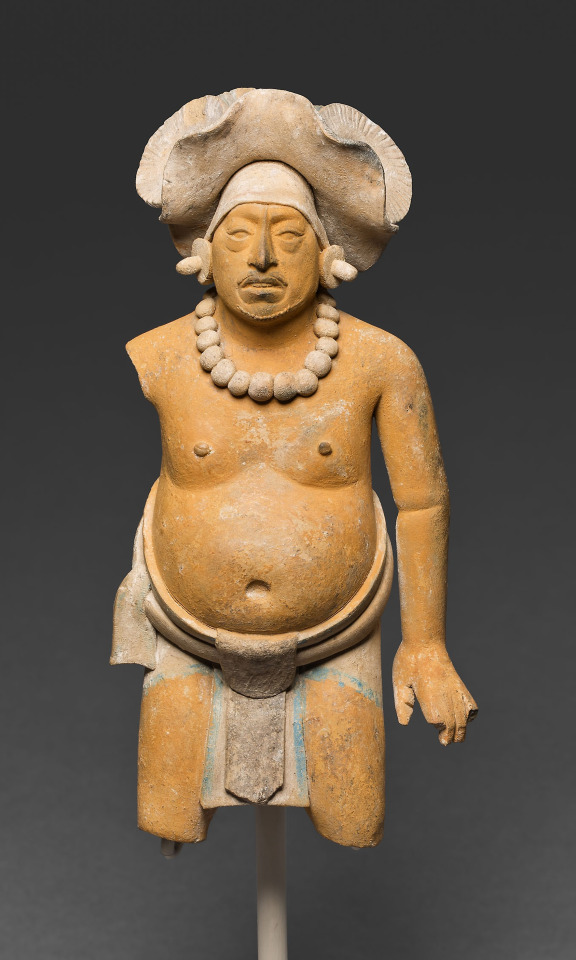
Standing Male Figure (650/800)
Jaina
Naturalistic Jaina figures often present detailed portraits of individuals. Men and women are delicately modeled in the poses, gestures, and costumes of those who ruled the Yucatán peninsula at the height of Classic Maya civilization, providing insight into their roles, status, and concerns. While most figures depict the social elite, such as ladies of the court, royal ballplayers, and priests, some also reflect interest in the range of Maya society members, including servants and captives wounded in battle.

Rattle in the Form of a Mythological Figure (650/800)
May be a dwarf
Jaina
Many of the hollow interiors of mold-made Jaina figurines were transformed into rattles or whistles. As musical instruments, they may have been played during the funerary ceremonies of the deceased whom they accompanied into the afterlife.

Ritual Vessel in the Form of a Head (600/900)
Yucatán
Flowering maize plant motif, scarification
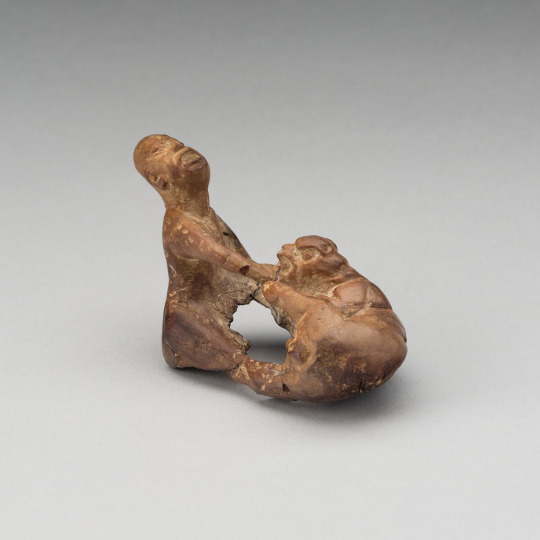
Figure of a Jaguar Attacking a Man (Probably 250/900)
Possibly Tabasco, Mexico
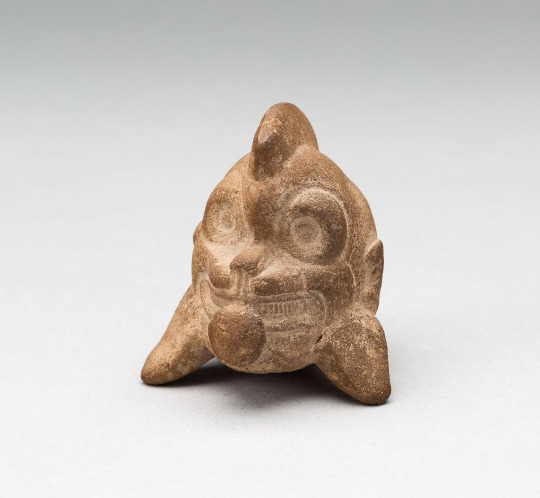
Whistle in the Form of the Head of a Jaguar (Possibly 250/900)
Possibly Jaina-style
Possibly Campeche, Mexico

Covered Vessel with the Principal Bird and Peccary Heads (200/300)
Petén region, Guatemala
This beautifully modeled and incised blackware vessel was likely was once the personal possession of a Maya king, who may have used it to serve food at royal feasts or who may have presented it as a gift to a visiting lord as a sign of alliance. Its shape—a lidded dish supported by four legs—was a form frequently produced during the Early Classic period [A.D. 250/450].
These ceramics often display a consistent set of motifs, with birds on their domed lids and inverted peccary (wild pig) heads serving as supports.
The artist who created this piece integrated the two-dimensional surface of the lid with its three-dimensional handle by connecting the bird’s spread wings, lightly incised into the surface, with its head, sculpted in the round. The vessel thus captures the essence of an aquatic bird floating on the surface of the water with its prey—a small fish—caught in its open beak.
Water birds and peccaries inhabited the natural landscape of the ancient Maya who associated them with the structure of the universe and the time of creation. The crest of feathers atop the bird’s head, its outstretched wings, and the bulge at the tip of its beak mark it as a cormorant.
The Maya regarded this bird as a liminal being, able to traverse three distinct environments: it flies in the sky, perches on land, and hunts fish by swimming deep under water. This was considered extraordinary, signifying the capacity to commune with supernatural beings that inhabit all three layers of the cosmos—a power that Maya kings also claimed to posses.
The cormorant bore many additional meanings with which these rulers wished to link themselves—for example, its association with watery realms alludes to fertility and agricultural abundance, which kings needed to ensure so that their community would survive. Water also evoked the distant mythological past, a time before the creation of the present universe when, according to Maya belief, everything was enveloped in a vast sea.
The peccaries furthered these cosmic associations as they are thought to have represented the four pillars that support the corners of the world. In addition, some Maya identified clusters of stars in the constellation Gemini as peccaries. This constellation is located in the region of the night sky where the seminal event of Maya creation—the resurrection of the maize god—was believed to have occurred.
All of these formal and iconographic features demonstrate that as a vessel made for a ruler and used in his court, this work was adorned with imagery designed to express the supernatural sources of his royal authority. In their art programs, Maya kings often associated themselves with the cosmos and the time f creation, thereby affirming that their right to rule was inherent in the world and was established at the beginning of time.
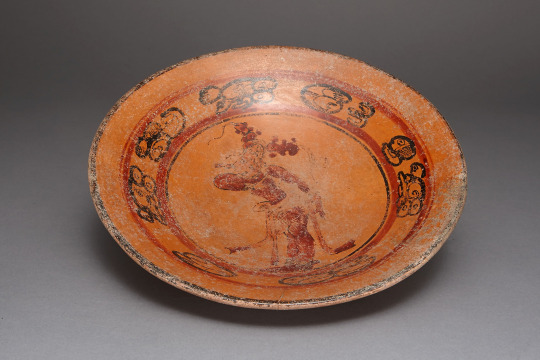
Plate Depicting a Dancing Figure (600/800)
Possibly Petén region, Guatemala

Plate in the Form of a Jaguar with Interior Painted with Floral-Like Motif (200/700)
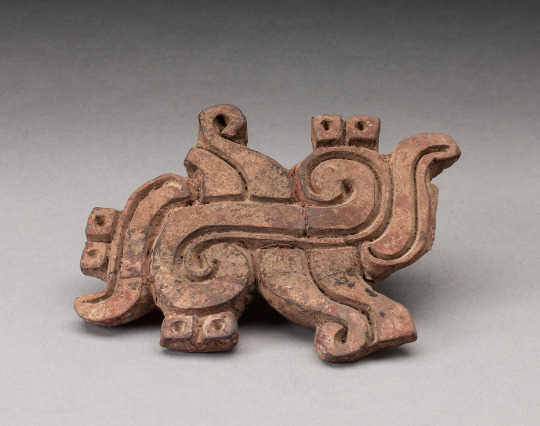
Stamp (300 B.C./A.D. 250)
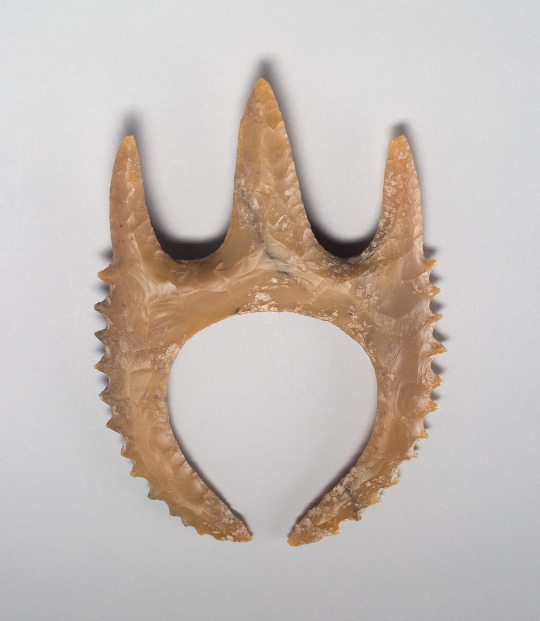
Eccentric Flint (200 CE)
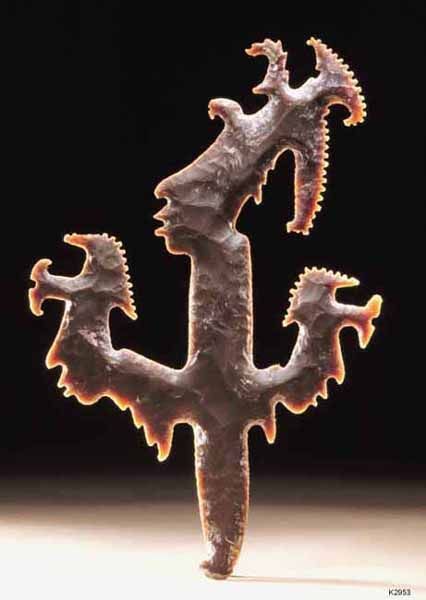
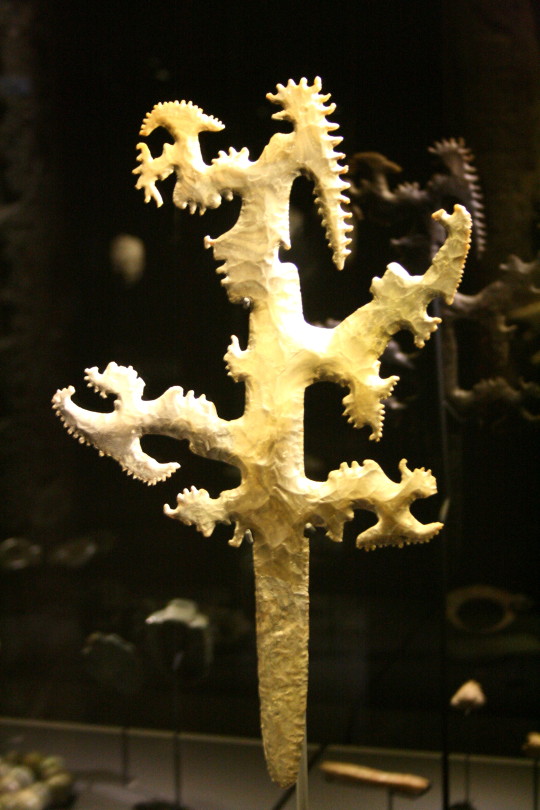
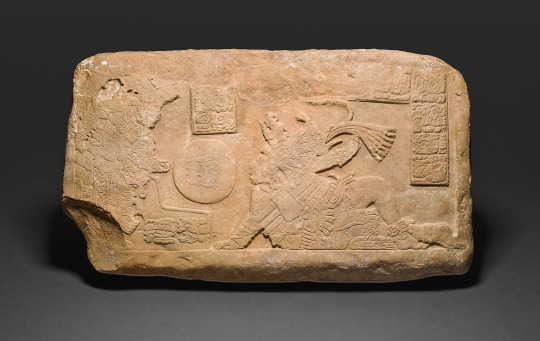
Ballplayer Panel (700/800)
Usumacinta River area, Mexico or Guatemala
In Central America, the best-known sculptors are the Maya, who decorated their temples and sacred precincts with finely carved stone reliefs representing powerful dynastic rulers involved in various secular and religious activities.
This fragmentary ball-court panel from the late eighth century shows two men, dressed in elaborate costumes, engaged in a ritual ball game. Surrounding the figures, and clearly set off from them, are fragments of hieroglyphs by which the Maya identified the players and the date on which the game occurred.
Calakmul Event
Great Turkey from La Corona, Guatemala on the right, and a ruler from Calakmul on the left.
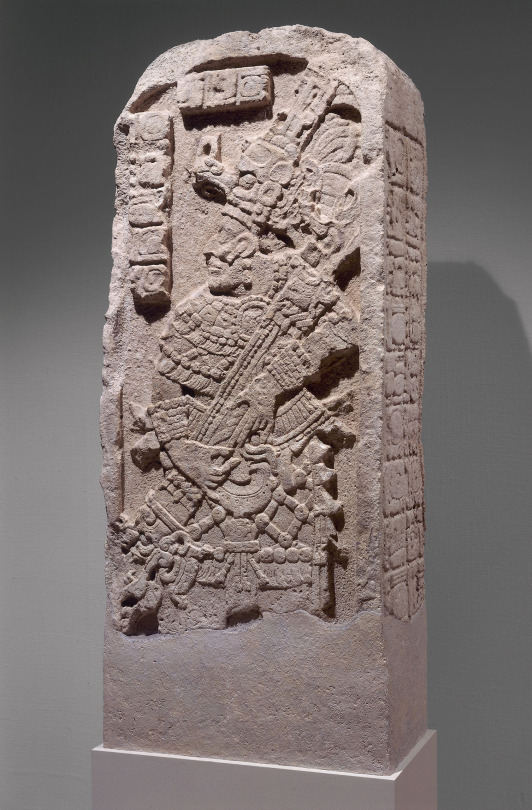
Stela (702 CE)
Vicinity of Calakmul, Campeche or Quintana Roo, Mexico
The lords of Maya city-states in southern Mexico, Guatemala, Belize, and Honduras portrayed themselves on stone monuments called stelae. Placed in plazas before the palaces and pyramids of ritual and administrative centers, these sculptures document critical information about major dynastic events between A.D. 200 and 900, including royal inaugurations, military triumphs, marriages, deaths, rituals, and key events of the agricultural cycle).
The carving style of the stela suggests that it may be from the vicinity of Calakmul, a major Classic Maya city located in Mexico’s Yucatán Peninsula, close to the border with the Petén district of Guatemala.
A male figure—likely a ruler—stands in a frontal position, with his head, lower legs, and feet (now missing) turned to the viewer’s left. The subject’s gaunt face suggests that he is elderly.
He holds a double-headed serpent bar across his body and is dressed in ceremonial attire associated with the Maize God, consisting of a plumed headdress, jade jewelry, a jade-netted kilt, and a spondylus seashell below the midriff. This costume symbolically connected the ruler to the earth, sky, water, and maize (corn).
Hieroglyphics carved on the left side of the monument record the date 9.13.10.0.0 in the Maya calendar, corresponding to January 26, A.D. 720, which marked the completion of a Maya 10-year period. The text on the right side documents the ritual auto-sacrificial bloodletting performed by the ruler to commemorate this significant moment in time. Although they are too highly eroded to read accurately, the hieroglyphs on the front of the stela likely name the ruler, his ancestry, and the place where he governed.
And the creation myth is depicted in the ruler
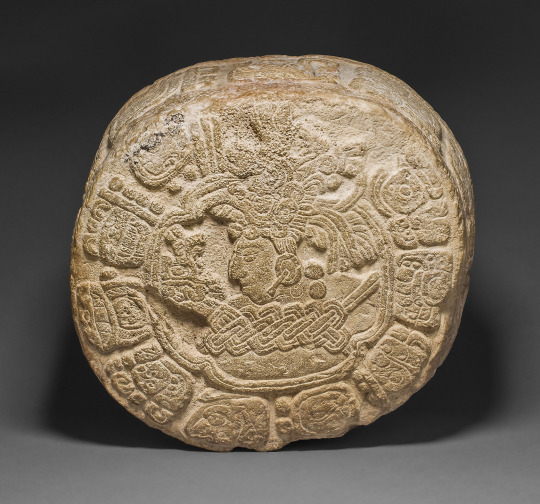
Hieroglyphic Altar (650/700)
Possibly Bonampak/Lacanha area, Mexico or Guatemala
This altar depicts the head and torso of an individual wearing an ornate headdress and a large, woven mat pectoral emblem of rulership. He appears within a four-lobed cartouche, suggesting that he is a deceased ancestor who lives in the Underworld.
The hieroglyphs that surround the figure describe the commemoration of a monument or structure; the text carved around the sides of the monument celebrate a successor’s completion of six years of kingship.
Holding the God K (dynasties and Lineages)
670 AD; From Bubbling Water

Hieroglyphic Panel (650/800)
Usumacinta River area, Mexico or Guatemala
The Maya developed hieroglyphic writing to record the names, births, marriages, alliances, victories and coronations, and deaths of their rulers.
Mythological events and religious happenings were also carefully chronicled. Today scholars are deciphering this script and linking the translated information to additional archaeological evidence in order to reconstruct ancient Maya history, belief, and culture. This fragment from a hieroglyphic panel contains calendrical information that was part of a longer text.

Pectoral (200/800)
This elegant chest ornament would have been part of a ruler’s ceremonial regalia. In Maya society, as among other Amerindian peoples, a ruler’s attire indicated rank, religious function, and place of origin. Such dress was highly regulated, and only members of the nobility wore jade and other greenstones as an expression of their wealth and high status. Moreover, these rare and valued stones were considered to be inherently sacred and powerful. By wearing jade regalia, kings directly associated themselves with the youthful green maize plant and life-giving blue-green waters.
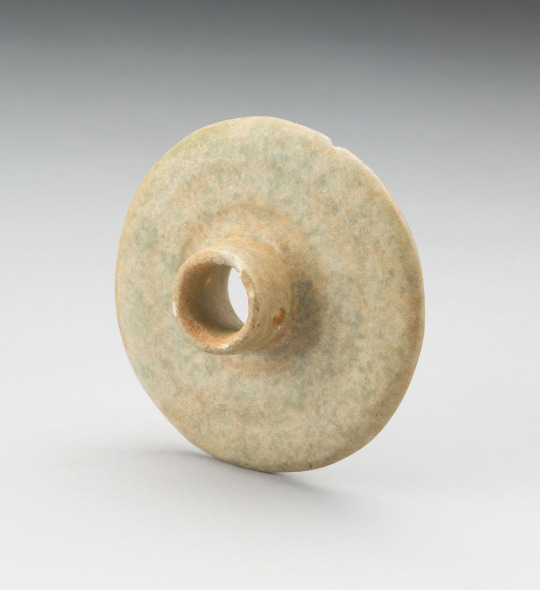
Ear Spool (250/900)
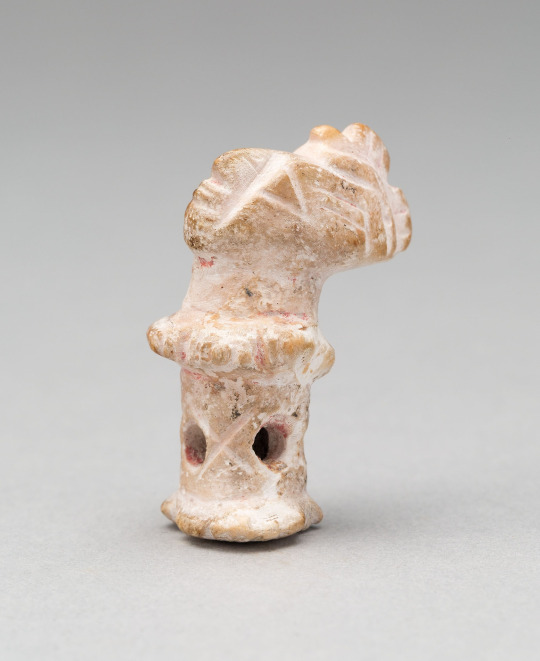
Labret (200/700)
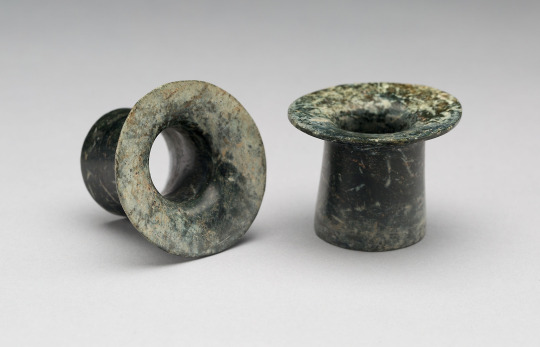
Pair of Ear Spools (250/900)
0 notes
Photo

WELCOME TO MONLEON:
FULL NAME: Natalie Nordegraf
OCCUPATION: Musician, Record Producer and DJ
AGE & D.O.B.: 26 / March 10th, 1994
RESIDENCE: Foncebadón
ORIGINALLY FROM: Monleon, Florida
HOW LONG THEY’VE BEEN IN TOWN: 17 years
BIOGRAPHY:
TW: light mentions of drugs and abandonment
Raised between New York and Florida, Natalie Nordegraf’s life was always a dichotomy of pushes and pulls, but then again, they were the type who loved working against the status quo. Their earliest memories were of white picket fences, people coming to their beck and call, and the quaint, pictorial scenes from their bedroom balcony―marble fountains and a great verdant lawn where they usually ran about, lost in a world of their own. Their early life was very much a spectacle: behind the scenes, nannies and professional caretakers played the part of their mother, and in the spotlight, on dark stages before the flashing paraphernalia of paparazzi, their mother played the part she had forsaken for the sake of freedom. Natalie, far from being a true conglomerate of Charlotte’s ornamental grandeur and Thomas’ natural born charisma, tried to smile through it all despite their discomfort with being in the spotlight, both a shot of malt and its remedy combined in a sweet dose, auburn-haired and brown eyed, a flaming glory which was only waiting for morning to bloom.
A pop of color in any landscape and incredibly ironic in a sense that was often viewed as different; they were the giggle at the funeral, the kid living in the phrase “go big or go home”. Growing up as a small celebrity in a big state, it wasn’t only the family money (vintage Porches, two rugged Golden retrievers, a snapping flagpole in the circular drive through), but the reputation which preceded them; which came to define the Nordegraf’s only child. Their family had long forged a straight and scenic path before Natalie, smoothing out every possible inconvenience that could have risen. Thomas was the money and the name, Charlotte his beloved, docile wife; and Natalie—well, Natalie was the one who seemed to break up the image of their perfect family, the one who appeared in the doorway, bright-eyed and tousle-haired, clothes stained with grass stains. Wild, unrefined.
Natalie was born with the kind of brain that took some growing into. Not necessarily on their part; they never questioned their own peculiarity when it was the rest of the world that seemed to lag a pace behind. Truthfully, Natalie was happy to be Natalie, but they were never happy being lonely. They loved having friends, few as they came, fleeting as they were. Lanky for their age and awkward, they sought out human connections eagerly and did not fail for lack of trying; making other kids like you was just a little harder when they seemed to exist on a different wavelength, and communication across frequencies didn’t come easily to them. When everyone else rushed outside to play kickball or hopscotch, Natalie spent their recess indoors—tapping at the glass of the classroom’s monarch tank, craning their neck nearly ninety degrees to solemnly peer at the hanging chrysalises. When the girls were chatting away about TV shows and giggling about their classroom crushes, Natalie tried to join in with a lively discussion about the latest Lord of the Rings book they’d just finished or their current favorite band to listen to—but got nothing but dirty looks in return. Once, after watching everyone else trade Pokemon cards at lunch, Natalie had brought in hand-made cards of their own creature inventions and shared them around happily. They’d found them all crumpled in the trash at the end of the day, the drawings crudely vandalized. At the time, they didn’t really understand it, but the reason for their ostracization was simple: “gifted” did not cancel out “weird” in the eyes of other fifth-graders.
So like most oddballs and offbeats, childhood was simply a waiting game for Natalie. There eventually came a time when being different was no longer the leprosy of the playground, and dragging around an over creative mind didn’t always get in the way of every social interaction they attempted. Being quirky was no longer weird; it was admirable, enviable, a label that came with it’s own inverted cool factor even in the face of the letterman-wearing jocks and pony-tailed cheerleaders. Now that the barriers had been lifted, their friendly and extroverted personality left them with no shortage of friends. Their quirks flourished in the company of those who could appreciate them. High school was also an era of enlightenment for Natalie in other ways; with their extraordinary knack for learning multiple instruments and blossoming love of all things artistic, they’d never even realized how starved they’d been on the music and art curriculum of their previous years until they started teaching themself. From the first time they learned to read sheet music to holding a guitar in their hands, they felt the click of something falling rightfully in it’s place. It didn’t get much closer to love at first sight than that.
For someone who’s brain had seemed to have a decent enough start, their personality took longer to fully bloom. Maybe it was those early years of classroom and home isolation that had stunted it, or the fact that even their identity needed some time to catch up with their creative flow; whatever the case, only by their last years of high school did the “weird girl” start to resemble the real Natalie Veronica Nordegraf: finally coming out as queer and non-binary, of eccentric style, multiplying tattoos, and the speaking rate of a NASCAR engine. The strange, colorful appearance gave off one impression; opening their mouth into an excited conversation about making synthesized music beats or the latest episode of Attack on Titan turned it into entirely another. By the time they embarked upon their four years at University, Natalie had self-actualized into such a bundle of contradictions that everything about them seemed designed purely to baffle people—but truthfully, they were never the kind of person to blueprint their personality.
Their parents decided that it was better off keeping their one and only child away from the spotlight for fear of extreme scrutiny concerning their peculiar nature. Unsurprising as Natalie hadn’t ever truly felt seen by their parents—especially after coming out. Their relationship with Charlotte and Thomas was always a difficult one, if anything non-existent. Still, when Natalie was just a freshman in college, their mother had a mid-life stroke and it affected them all the same. Natalie was ready and willing to drop all their classes and fly home on the next available flight, but their father assured them there was no need for such drastic measures—they were to stick to their studies, and things would be just fine at home. And they were, for a while. Charlotte battled her way through a long, slow recovery to retrain some of the functions she’d lost, and regain pieces of the charismatic, sharp-witted woman she’d always been—until the second stroke blindsided them all. This bleed was worse than the last. It was a hemorrhage Hiroshima that wilted Charlotte Nordegraf overnight, and wiped her personality clean like a hard drive. Natalie didn’t even get a chance to say goodbye to their mother—the real Charlotte, not the empty husk that had replaced her by the next morning.
Their mother’s steep and sudden decline was a fissure that would eventually crack the family completely in two; Natalie, helpless and frustrated in grief, found themself blaming their father for not prioritizing their own mother over a year or two of school. Maybe being at home would’ve helped her. Maybe it would’ve changed things. The crack soon widened into a chasm when their father admitted that he was looking into long-term care facilities that could provide for his wife better than he could; Natalie protested vehemently, but argument after argument amounted to nothing. From that moment on, Natalie let the distance between them grow without so much as another phone call. Taking on one part-time job, then another, Natalie found that a constant stream of work kept their brain a little too exhausted for them to continue on with their studies. Eventually, instead of becoming a security blanket school became a burden; and Natalie found themself dropping out.
The next three years passed by in a blur after that; they shacked up with some friends turned roommates, got a few new tattoos, learned more instruments, and tried to focus more on their passions despite the unresolved trauma they carried with them. Eventually, Natalie moved inside the old house that their father never frequented and that they grew up in—entirely too large for one person but they found a small solace in the space surprisingly. Ever since, Natalie has tried to anchor their life as best as they could in their hometown. Though their family is now a family of their own choosing: people who love them as unapologetically as Natalie loves them. Though their heart may still ache for what has been lost, it’s a pain that will soften with time; for now, they are content to find comfort simply in belonging. All those years of loneliness, all that time spent hungering for friends to call their own, and it’s back home in Monleon that they’d found their place—and the utmost fulfillment of a puzzle piece that’s finally discovered where it fits.
They prefer to dwell in the positive. Natalie’s passions include music, playing gigs with their band Dommy Mommy Propaganda, gaming, learning to play new instruments, animals, burgers, fries, beer, and lots of weed. On a typical night out, Natalie will be amiable, easygoing, give off a lot of himbo/bimbo energy while being effortlessly awkward. As they talk weightlessly, you may notice a sadness lurking behind their eyes. As they swig their beer, you may also notice them absently thumbing the tiny, claw-machine silver pendant that hangs around their neck—the rare gift from their mother. Though they still dare to dream big; they are currently getting into producing and putting more of their music out there.
NATALIE NORDEGRAF is portrayed by BRIGETTE LUNDY-PAINE and written by TOMMIE.
0 notes
Text
A question of tolerance
Our public figures must rediscover the true spirit of liberty
DOUGLAS MURRAY
It has become fashionable in recent years to talk of the death of liberalism. But as crowds high on the octane of generational self-righteousness rampage through major cities, the evidence mounts. The growing intolerance of freedom of thought, the inability to talk across divides, the way that most of the British establishment, police included, feels the need to pledge fealty to the cause — as though all terrified of ending up on the wrong side — points to a crisis of more than confidence. It is evidence of an underlying morbidity.
Each day the cultural revolution is picking up a pace, with the iconoclasts who attacked the Cenotaph and the statue of Winston Churchill looking for new focuses for their rage. The University of Liverpool has announced that its Gladstone halls of residence will be renamed after protestors pointed out that the former prime minister’s father had owned slaves. So there goes the ‘sins of the father’ ethic too. Nervous broadcasters have started removing programmes ahead of any stampede, with the BBC withdrawing Little Britain and HBO taking out Gone with the Wind from their streaming services in case the woke eye of Sauron flashes on them.
What we are seeing is nothing more or less than the death of the liberal ideal.
Of course ‘liberalism’ was always a broadly defined term; a definition made only vaguer by Americans making it synonymous with ‘left-wing’. But in the truest political sense it encapsulates most of the foundations of our political order, including (though not limited to) equality, the rule of law and freedom — including the freedom of speech that allows good ideas to win out. In the past few years, left-wing critics have been keen to identify what they see as the erasure of liberal democracy by popularly elected leaders on the political right. But in our own country, the much more serious assault on political liberalism comes not from the conservative right, but from the radical left.
Over the past couple of weeks, well–meaning people have poured almost a million pounds into the coffers of Black Lives Matter UK in the belief that they are helping a movement that will help black people. In fact they have funded a deeply radical movement. On its own fundraising page, BLM UK describes its aims as: ‘to dismantle imperialism, capitalism, white supremacy, patriarchy and the state structures.’ So as well as dismantling a nonexistent menace (‘imperialism’) it intends to bring down the economy and completely alter relations between the sexes (negatively characterised as ‘patriarchy’). This is not liberalism, but far-left radicalism of a kind that has become very familiar of late.
Some people watching events of recent days will have been surprised by how far and fast such sentiments have run. By the sight of a mob in Bristol tearing down a statue and then jumping on it. By a Labour MP saying: ‘I celebrate these acts of resistance. We need a movement that will tear down systemic racism.’ By the ranks of British police who could find no way to respond to this behaviour other than (in a newly invented act of faith) to ‘take the knee’ before it. And then there is the media, which has chosen to provide cover for such violence and purge from their ranks not just people who dissent from it but, in the case of the New York Times a few days ago, anyone who helps publish someone who dissents.
As one of the last liberals left at that newspaper, Bari Weiss, explained it last week, the over-forties in the news business (like so many others) imagined that the people coming up under them shared their liberal worldview. Then they discovered that these young people believed in ‘safetyism’ over liberalism, and ‘the right of people to feel emotionally and psychologically safe’ over ‘what were considered core liberal values, like free speech’. Actually the divide is even bigger than that, and now encompasses nearly everything. Where the liberal mind is inquiring, the woke mind is dogmatic. Where the liberal mind is capable of humility, the woke mind is capable of none. Where the liberal mind is able to forgive, the woke mind believes that to have erred just once is cause enough to be ‘cancelled’. And while the liberal mind inherited the idea of loving your neighbour, the woke mind positively itches to cast the first stone.
Readers of The Spectator have known this was coming. When this magazine first wrote about the Stepford Students, it was asked why we take this so seriously — surely the students would grow up? And they did: but they didn’t change. The virtue–signalling of large corporations — the growing legions of diversity officers and ‘implicit bias training’ — was also written off as the silliness of the corporate world. When we described the mandatory requirement in government to prove a ‘commitment to diversity’ in order to be eligible for any public appointment, it was greeted with the same dismissal. As the American journalist Andrew Sullivan (himself now seemingly muzzled, if not cancelled) put it two years ago: ‘We all live on campus now.’
Step by step, the UK came to have a public and private sector dedicated to the implementation of views which are barely distinguishable from those of the protestors who took to the streets in the past week or two. It’s an ethic which demands that our society play a set of impossible, unwinnable games of identity and ‘privilege’ that not only subvert but end any idea of tolerance.
All of this emanates from those who come out of university educated to loathe our society, believing it to be characterised by the oppression of certain groups by other groups: a shameful history and a shameful present. Today these people head into professions where their language of aggressive superiority (‘Educate yourself’) is used to intimidate their elders, force every-one to agree with their point of view and otherwise make themselves unsackable.
As with all movements that catch, they aren’t on to nothing. Inequalities and inequities do exist, here as in all societies. Reasonable people disagree about how to address this. But the new illiberal radicals do not share that worry. For them, every inequity that exists (financial, familial, social, neurological) is the result of the same thing: discrimination. A thing we must ‘tackle’, ‘eradicate’ and otherwise cleanse from existence. There’s an awful lot of work to do.
Even the woke analysis of history that now sees them scouring the land for more statues to assault is radically different from that of the liberal mind. Liberals understand that people in history acted with the knowledge they had at the time, and that the task of those looking back is to look on it with understanding, not least in the hope of being understood in turn. The woke mind abhors this. It knows that it is right, and that everybody before this year zero was a bigot. After the weekend’s vandalism against London monuments, the capital’s Mayor, Sadiq Khan, announced that his ‘Commission for Diversity in the Public Realm’ would sit in judgment on all racist statues in the capital. Within hours, the Museum of London had already brought in the cranes to remove an errant statue on West India Quay.
In such ways has the free exchange of ideas about our past and present been replaced by a series of demands and assertions that demand everyone else’s compliance. ‘Silence is violence’ is one favoured line, meaning that if you do not agree with the radicals, you are perpetrating an act of violence. Naturally this assertion comes from the same people who have spent a lot of time asserting that words (such as ‘mis-gendering’ someone) are violence. While the violence of the past few days is not violence.
It is on the lip of this trap that our representatives and public figures have teetered over the past week or two, unable to work out how they can avoid a step they intuit to be deadly. What they need to do is pause and fundamentally change the terms, basing their appeal not just on reason but on a truly liberal spirit. It should be one which emphasises that the claims being made are unjust. It is unjust to portray the whole of American society, in all of its complexity, as typified by a policeman who is awaiting trial for murder. And it is even more unjust to think that his actions reveal some deep truth about the British police, or the British state, let alone everybody who is white. Equally, it is not just unjust but vindictive to pretend that any contradiction of your world view is merely a display of ‘white privilege’, ‘white fragility’ or ‘white tears’.
Unwittingly or otherwise, those who use these terms subvert one of the last great additions to liberal thought: that aspiration expressed by Dr Martin Luther King half a century ago. For when Dr King talked about the need to judge a person by the content of their character and not by the colour of their skin, he gave us something that was not just a great moral insight but — in an increasingly diverse society — the only solution. A year before his death, Dr King gave a speech titled ‘Where do we go from here?’ in which he said: ‘Let us be dissatisfied until that day when nobody will shout, “White Power!”, when nobody will shout, “Black Power!”, but everybody will talk about God’s power and human power.’
The people who have come after Dr King have spent years busily inverting that dream. In the name of black agency they try to deny white people agency. In the name of assailing white supremacy they end up by asserting black supremacy. And in order to make up for the sufferings of people who are no longer alive they demand vast wealth transfers today based on racial grouping. It is hard to imagine a more divisive programme, all carried out in the name of anti–racism. What they are actually doing is busily re-racialising our societies. Which is how you come to the situation where a cabinet minister is quizzed on Sky News about the precise ethno-racial composition of the British cabinet and certain ‘anti-racists’ can be found on social media noting with disapproval the number of people of Asian descent in the cabinet.
Any movement that says ‘Things are so bad that this whole thing needs to be pulled down’ should be encouraged to realise, before they have to experience it, the cost of what they are abandoning. And to remember the central truth about how much easier it is to pull down than it is to build. They must be responded to by people of every skin colour and background with a polite but firm ‘No’. Not just because the things that they are attempting to pull down include the only things that are capable of holding us all up. But because if everything that got us here was so bad, then what we are living in wouldn’t be so unusually good.
spectator.co.uk/podcast - Douglas Murray and Kate Andrews on the future of liberalism.
0 notes
Text
As Men Are Canceled, So Too Their Magazine Subscriptions
Imagine if Kodak had answered the threat of digital photography by pivoting from film to outdoor grills.
Imagine if Blockbuster had taken on the challenge from Netflix by shifting from DVDs to fast food.
Imagine if men’s magazines stared down the post-#MeToo manpocalypse by disowning men.
Maybe the last one isn’t so hypothetical?
At a time when calls are growing for the Oscars, Tonys and Emmys to follow the Grammys and the MTV Video Music Awards in erasing gendered categories, and to do away with gender-specific magazines, bro bibles like GQ, Esquire and Playboy seem poised to do a backpedal of Michael Jackson moonwalk proportions from the formula that kept them perched at the publishing pinnacle for a half-century.
Namely, being a print version of your father, offering up bourbon-breathed tutorials on the arts of tie knotting, fly casting, and skirt chasing.
In the gender tornado of 2019, men’s magazines, it seems, are canceling themselves. (The internet’s assault on glossy print isn’t helping either.)
“How do you make a so-called men’s magazine in the thick of what has justifiably become the Shut Up and Listen moment?” wrote Will Welch, the editor of GQ, in a cri de coeur introduction to this month’s “New Masculinity” issue. “One way we’ve addressed it,” he continued, “is by making a magazine that isn’t really trying to be exclusively for or about men at all.
So gender fluid it’s soggy, the 128-page issue might well have been themed “No Masculinity,” with its androgynous cover image of Pharrell Williams looking like an inverted tulip in a floor-length yellow Moncler Pierpaolo Piccioli coat, followed by ruminations on the “weaponized” male body by Thomas Page McBee, a transgender writer and boxer; a defense of makeup for men by EJ Johnson, Magic Johnson’s son whose fashion tastes run toward fur shawls and diamond chokers; and a debunking of the power of testosterone itself by Katrina Karkazis, a cultural anthropologist and author.
Such untraditional content is a survival strategy for glossies with a Y chromosome tilt in this homo novus era, where every reference to masculinity wears an implied “toxic” like a hair shirt.
Even Playboy, mired in identity crisis since dial-up modems, is suddenly woke.
The magazine has rechristened its Bunnies as “brand ambassadors,” and even embarked on a short-lived experiment to cut out the nudes. After the death of its founder Hugh Hefner in 2017, Playboy has morphed into an art-book quarterly that ditched its old tee-hee-hee motto, “Entertainment for Men,” for a gender-blinkered “Entertainment for All.”
It’s an open question whether the men who now turn to Pornhub and its ilk for the kind of “entertainment” that Playboy built an empire on even noticed.
Even so, the magazine, which long held up Hef, with his phallic-symbol pipe and star-studded skin romps at the Playboy Mansion, as the epitome of American straight male aspiration, is turning the brand’s hyper-male, hyper-hetero legacy on its head.
The magazine’s new leadership team consists of a gay man (the executive editor Shane Singh) and two women (the creative director Erica Loewy and Anna Wilson, who is in charge of photography and multimedia), all millennials.
Recent feature articles include profiles of Andrea Drummer, a female African-American chef who runs a cannabis-centric restaurant in Los Angeles, and King Princess, a genderqueer pop singer who is as a symbol of self-acceptance to young L.G.B.T.Q. fans.
For a cover image this summer, the team commissioned the fine-art photographer Ed Freeman (a rare man who still shoots for Playboy, though he is gay) for an arty underwater shot featuring three featuring female activists for causes like ocean conservation and H.I.V. awareness.
“The water,” Mr. Singh explained to Jessica Bennett of The New York Times for an article in August, “is meant to represent gender and sexual fluidity.”
Change is also afoot at Esquire, the tweediest of the men’s titles, which for decades carried a whiff of dad’s old cedar chest full of pocketknives and Mickey Mantle baseball cards.
This past June, the magazine installed its second editor, Michael Sebastian, in three years. Mr. Sebastian, 39, made his name as Esquire’s digital director, where he oversaw a significant rise in traffic to the site, according to Hearst.
His appointment as editor prompted industry speculation that he was going to go “full Cosmo,” chasing Instagram-friendly content and trending topics on Twitter just like Cosmopolitan, Esquire’s sister publication at Hearst that has lately been pursuing data as hotly as it long proselytized multiple orgasms.
The move seemed symbolic. Mr. Sebastian replaced Jay Fielden, a dapper Texan given to Hemingway and Cifonelli suits, who had departed weeks before, citing the lure of new (and unspecified) possibilities. Mr. Fielden had vowed to revive the “literary charisma” of the magazine of Fitzgerald and Dos Passos. He may have fit the image of the “Esquire man” too well for the times.
In one of his first interviews after he got the job, Mr. Sebastian took a swipe at the publishing patriarchy, telling The Wall Street Journal that he wanted to get away from the idea “that both the Esquire reader and writer is a middle-age white guy who likes brown liquor and brown leather.”
In fairness to Mr. Fielden, he said pretty much the same thing years ago, before Harvey Weinstein and his ilk sent half the population to the penalty box. “There’s no cigar smoke wafting through the pages,” he said to The New York Times in 2017, “and the obligatory three B’s are gone, too — brown liquor, boxing and bullfighting.”
As the same article reported, Mr. Fielden had won the job in part because he courted more male readers to the traditionally feminine Town & Country, the Hearst title he headed before Esquire.
At Esquire, he vowed to lure more female readers and ditched boys’ club staples like the print version of the “Women We Love” issue.
Apparently, it was not enough. Could anything be? Perhaps not, as manhood itself is being interrogated, scrutinized and radically revised.
The very idea of a men’s magazine now sounds “as hopelessly passé as a private gentlemen’s club,” according to a recent article, “The End of Men’s Magazines,” in City Journal, which is not exactly a progressive organ (the magazine is published by the Manhattan Institute, a free-market think tank).
Maybe. Or maybe not.
Details is done. Maxim has evolved its identity from a frat-house must-read to a cosmopolitan lifestyle magazine, an about-face that began under a female editor and fashion veteran, Kate Lanphear, who departed in 2015.
But Esquire has already survived the Great Depression, World War II, disco, yuppies and the dot-com bust. It’s still here.
And plenty of readers are still here, too, even in a brutal publishing climate that has forced august women’s titles like Glamour, Seventeen, Self, and Redbook to retreat from print for the web.
Despite a plunge in newsstand sales that has plagued the whole industry, Esquire still had an estimated total average circulation of 709,000 for the first six months of this year, according to the Alliance for Audited Media; the figure accounts for both print and digital subscriptions as well as single-copy sales.
GQ, too, is a long, long way from life support, with a figure of 934,000 for the same period, according to the alliance.
Times change, sometimes violently. But recent history is full of apparent anachronisms (gas guzzlers, Birkenstocks, Donald Trump) that managed an unlikely second act. And men’s magazines have proven pretty adept at sniffing out the shifts in culture, both trivial and seismic, over the decades — which is one reason they have been around for decades.
Esquire may have swaggered into the 1960s as the Don Draper of magazines, but as the old order began to crumble thanks to Betty Friedan, the Black Panthers and many others, the magazine’s editor, Harold Hayes, quickly detoured into a flower-power-era version of woke.
He commissioned Susan Sontag’s dispatch from Hanoi at the height of the Vietnam War, and James Baldwin’s ruminations on race in America after the assassination of the Rev. Dr. Martin Luther King Jr.
Even Playboy opened its pages to thought-provoking interviews with Eldridge Cleaver, Malcolm X and Fidel Castro while sprinkling in at least a few pictorials featuring Playmates of color.
Yes, that was a different time. We’ve come a long way from Gloria Steinem decrying “The Moral Disarmament of Betty Coed” thanks to the Pill in Esquire in 1962, to Hannah Gadsby, a lesbian comedian, taking aim at “hypermasculine man-babies” in GQ’s “New Masculinity” issue.
Haven’t we?
Sahred From Source link Fashion and Style
from WordPress http://bit.ly/2PGZLeC
via IFTTT
1 note
·
View note
Photo

Chara~ Character Information Also known as The First Human The Fallen Human Relationships Toriel (adoptive mother) Asgore (adoptive father) Asriel (adoptive brother) Table of Contents Greetings. I am .Chara's introduction at the end of a Genocide Route Chara (typically /ˈkærə/ or /tʃɑːrə/), also known as the first human or the fallen human, is the first human to fall into the Underground. Chara is also the fallen human that the player names at the start of the game, and not the controllable character who is played throughout the entirety of Undertale. Profile Appearance n sense," as said by Asriel, and just like the protagonist, has an ambiguous gender. Both appear to have been around the same age after falling into the Underground. Chara's SOUL is also the same color as the protagonist's, which is indicated by the red SOUL on Chara's coffin. At the end of the Genocide Route, Chara is seen to be wearing a lime and cream colored striped shirt (which is an inverted color of the protagonist's shirt) and red-brown pants and shoes. Compared to the protagonist, Chara has lighter skin and hair color, rosey cheeks, open eyes, and a smile that contrasts the protagonist's stoic expression. Personality Young one, when I look at you... I'm reminded of the human that fell here long ago... You have the same feeling of hope in your eyes.Asgore's extended monologue if Flowey was killed in the previous run While initially cast in a sympathetic light, Asriel admits at the end of the True Pacifist Route that Chara "...wasn't really the greatest person." Asriel states that Chara climbed Mount Ebott for an unhappy reason, and adds that Chara "hated humanity". Chara never told Asriel the reason that they had such hatred. Asriel also mentions that Chara "laughed it off" when the two of them accidentally poisoned Asgore by putting buttercups instead of cups of butter into a butterscotch pie they made for him. At the end of the Genocide Route, Chara behaves in a polite, deliberate manner, thanking the protagonist for guiding them. However, if the protagonist refuses to destroy the world, Chara immediately becomes malevolent, despite the outward semblance of youth and innocence. Chara reveals that the protagonist's "determination" and "human soul" awoke Chara from death as soon as the protagonist entered the Underground. Main Story After falling into the Underground, Chara was taken in by Toriel and Asgore as a second child and was treated with respect equal to their biological son, Asriel. Chara and Asriel became best friends. Monsters spoke of how Chara filled the Underground with hope. One day, after becoming terminally ill from consuming buttercups, Chara expressed the desire to see the Golden Flowers found in their home village. After their death, Chara's SOUL was absorbed by Asriel, and they shared control over a body. Chara carried their own corpse across the barrier and wanted to use their full power. Asriel resisted Chara, which ultimately led to the humans killing the fusion of the two SOULs. Chara's motives in this situation are uncertain. In the fourth True Lab tape, Asriel says "Y...yeah! We'll be strong! We'll free everyone.", and in the fifth "Six, right? We just have to get six..." In the Genocide Route, Flowey tells Chara that they should finish what they started and free everyone. Flowey also adds, "Then... let's let them see what humanity is REALLY like. That despite it all... This world is still 'kill or be killed!!". Asriel tells the protagonist that he came up with this philosophy because his resistance to Chara had led to both of them being killed. At the end of the Genocide Route, Chara says little about Asriel's betrayal other than, "At first, I was so confused. Our plan had failed, hadn't it?" Chara's body was originally laid to rest in a coffin in the basement of the castle, where the bodies of the other fallen humans would later be put. When she left Asgore, Toriel carried Chara's body to the Ruins and gave them a proper burial. In the Genocide Route, Chara says that the protagonist's "determination" and "human soul" awakened them from death. There is evidence that some narration, as well as descriptions of certain actions and events, is by Chara themself. However, the narrator throughout the entirety of Undertale is up to speculation. Neutral Route When the protagonist gets a Game Over, Asgore's voice can be heard as he urges Chara to "stay determined." The messages seen on the game over screen are identical to what Asgore said to Chara while they were on their deathbed. , huh? That's a nice name. My name is...Asriel Dreemurr introducing himself to Chara, in a reminiscence at the Garbage Dump The protagonist also hears Chara's name in their dreams. If the protagonist sleeps in the bed in Toriel's home, Asgore's voice can be heard as he pleads, ", please... Wake up! You are the future of humans and monsters." When the protagonist first falls into the Garbage Dump, Asriel's first words to Chara appear on the screen, narrated with Asriel's voice bite. True Pacifist Route ! You have to stay determined! You can't give up... You are the future of humans and monsters...VHS tape recording of Asgore from the True Lab In the True Lab, VHS tapes of Chara interacting with their family can be played back. None of these VHS tapes include visuals and provide narration alone. Most of these tapes are of Asriel and Chara, and prove that Chara had a "plan." In one of the tapes, Asriel tells Chara to wake up and that "he doesn't like this plan anymore." Asriel's quote is speculated to be something that he said to his dying sibling because this same VHS contains the quote seen on the game over screen. Towards the end of the fight against Asriel, when the protagonist calls out "someone else"'s name, flashbacks of Chara and Asriel play. They show Chara's fall into the Underground, Asriel's discovery of Chara, and the royal family spending time with Chara. After the fight, Asriel recognizes the protagonist as Frisk. During the epilogue, Frisk may return to the room containing the coffins of the other humans. This leads to the discovery that all of the coffins are empty, and that there are mummy wrappings at the bottom of Chara's coffin. Genocide Route We're still inseparable, after all these years... Let's destroy everything in this wretched world. Everyone, everything in these worthless memories... Let's turn 'em all to dust.Flowey, upon identifying the protagonist as Chara. While traversing the Genocide Route, many characters comment on the protagonist's creepy smile. Sans comments that it would be great if the protagonist continued pretending to be a human, and Asgore inquires what kind of monster the protagonist is. At the end of the Ruins and when going through New Home, Flowey determines that the protagonist is empty inside, just like himself. He concludes that the protagonist is Chara, and informs them of a plan he has to become omnipotent. Chara seems to be in control of the protagonist's scripted sequences, as the sequences in the Genocide Route differ from the Neutral and True Pacifist Routes. Instead of following other NPCs commands, the protagonist defies them and becomes merciless as the route progresses. The first example of defiance occurs when the protagonist ignores Sans's request to hide behind the conveniently shaped lamp; the last is when the protagonist kills Flowey before Chara makes their appearance. The only instance in the game where Chara makes an in-person physical appearance is at the end of the Genocide Route. They appear as an overworld sprite and speak into the fourth wall. Chara could be speaking directly to the player in this sequence. After this appearance, Chara reveals that the protagonist's "human soul" and "determination" were the cause of their reincarnation and that the merciless events that occurred during the route lead Chara to realize that the purpose of their awakening was power itself. Chara states they are the embodiment of the feeling received whenever STATS increase and proposes erasing the world and moving on to the next. The protagonist is given the choices to "ERASE" the world, or "DO NOT." Both choices lead to the same result. If the protagonist chooses to "ERASE," Chara calls the protagonist "a great partner." Additionally, their eyes widen, and Chara says to the protagonist that they will be "together forever."If the protagonist chooses "DO NOT," Chara's eyes widen, and they say that the protagonist was never in control. Afterward a disturbing jump scare occurs, in which Chara approaches the screen with a horrifying laugh. The screen (or game window) shakes while a loud droning sound loops in the background. After the protagonist makes their choice, an attack animation occurs, followed by red "9"s covering the screen. The game is forced into windowed mode and shakes similarly to a monster's death animation as the game closes. The player cannot exit the game before the crash unless they use the OS's Task Manager. Upon reopening the game, the screen is black and accompanied by a sound similar to howling wind. After 10 minutes, Chara speaks to the protagonist, sensing that they want to go back to the game's world, and reminds the protagonist that their actions caused the world's destruction. After asking the protagonist if they think they are above consequences, Chara offers to restore the world in exchange for something, later revealed to be the protagonist's SOUL. If the protagonist agrees to this trade, the world is restored, but the True Pacifist ending is permanently altered.Refusing this offer causes Chara to abandon the protagonist, only to offer the same choice again after the game is restarted and another 10 minutes elapse. Post-Genocide Game True Pacifist Chara appears briefly after the True Pacifist Ending Credits if a Genocide run has been completed beforehand. If the protagonist chose to stay with Toriel, the after-credits scene continues briefly after Toriel closes the door, showing Chara in place of Frisk turning to face the screen with red eyes. The game cuts to black, with laughter similar to Flowey's, but slowed down and lower-pitched. Similarly, if the protagonist decides to have "places to go," the photograph after the credits has the face of everyone crossed out in red, except for Chara, who replaces Frisk. The "THE END" text is red, and a slowed down version of Anticipation plays. The Annoying Dog does not appear to sleep under the ending screen. Genocide Route After completing a Genocide Route a second time, Chara takes on the description of "the demon that comes when people call its name." Chara says that the reason the protagonist continues to recreate and destroy the world is an incomprehensible "perverted sentimentality," before suggesting that the protagonist takes a different path if they choose to create the world again. Chara gives the protagonist the "choice" to erase the world again. If the protagonist chooses "ERASE," Chara once again calls the protagonist "a great partner," saying they will be together forever.Choosing "DO NOT" causes Chara to tell the protagonist that these feelings were exactly what they were just talking about. Chara then reminds the protagonist they made their choice a long time ago, causing another jump scare, as the world is destroyed again. However, when the game is rebooted, the game loads normally. Relationships Asriel After falling into the Underground, Chara is found by Asriel and returned to his parents; Toriel and Asgore. The two of them grew together as siblings and best friends. Flowey Flowey perceives Chara as his partner and best friend despite his inability to love. Seeing Chara as a creature akin to him, he helps by clearing all obstacles in the way. He says that Chara would never give him any "worthless pity" and is the only one who understands him. Protagonist The protagonist only learns about Chara if a Genocide Route is completed. As the protagonist kills monsters and gains more EXP, Chara seems to grow stronger. Chara refers to the protagonist as a "partner" if the protagonist accepts Chara's offer to erase the world. If the protagonist completes another Genocide Route, Chara questions why they continuously recreate and destroy the world. Chara then goes on to say that the protagonist has a "perverted sentimentality" that drives this odd behavior. Toriel When Chara fell into the Underground, Toriel took on the role of Chara's mother. She cared for Chara very much, equally as much as Asriel. Toriel and Chara both greet new figures using "greetings" (Toriel to the protagonist at the beginning of the game, Chara to the protagonist at the end of a Genocide Route). It is likely Chara inherited this behavior from Toriel. Asgore Similarly to Toriel, Asgore acted as much of a father to Chara as he did to Asriel. It can be speculated that Asgore's "Mr. Dad Guy" sweater was made by Chara, due to the text that appears when checking it while in New Home during a Genocide Route. Chara In-Game In several moments throughout the Genocide Route, Chara temporarily disables the player's input and takes direct control of the protagonist. The first instance of this is when the protagonist does not hide behind the conveniently shaped lamp when Sans asks them to.The second instance of this is during the first encounter and puzzle with Papyrus, where the protagonist seems to ignore Papyrus and moves forward independently.The next instance of this is before the battle with Undyne the Undying, where the protagonist turns away, and then approaches Monster Kid aggressively.Another instance of this is during the two encounters with Mettaton, who notices the protagonist's eagerness to fight him.The penultimate instance of this occurs just before the Sans encounter, as the protagonist moves forward to provoke Sans into fighting. The protagonist also deals the killing blow to Sans without any input from the player. The second strike dealt to Sans, which comes without input from the player.The last instance of this is in the Throne Room, where without any input from the player, Chara kills Asgore without hesitation. As with Flowey, several strikes are dealt if the player presses "ENTER/Z" a single time. Furthermore, the text that the protagonist sees changes depending on Chara's voice and thoughts. These narrations are sometimes, but not always, red in color (A list of them can be found on the Genocide Route page). Chara's perception of various objects also changes depending on the route, most notably the Heart Locket and Worn Dagger, which Chara narrates as being simply "The Locket" and "Real Knife" in the Genocide Route. Dialogue Genocide Route Ending Greetings.I am .Thank you.Your power awakened me from death.My "human soul"...My "determination"...They were not mine, but YOURS.At first, I was so confused.Our plan had failed, hadn't it?Why was I brought back to life?...You.With your guidance.I realized the purpose of my reincarnation.Power.Together, we eradicated the enemy and became strong.HP. ATK. DEF. GOLD. EXP. LV.Every time a number increases, that feeling...That's me."."Now.Now we have reached the absolute.There is nothing left for us here.Let us erase this pointless world, and move on to the next.[Erase]Right. You are a great partner.We'll be together forever, won't we?[Do Not]No...?Hmmm...How curious.You must have misunderstood.SINCE WHEN WERE YOU THE ONE IN CONTROL? Abyss [After a completed Genocide Route, after the player waits ten minutes after booting up the game.] Interesting.You want to go back.You want to go back to the world you destroyed.It was you who pushed everything to its edge.It was you who led the world to its destruction.But you cannot accept it.You think you are above consequences.Exactly. [Yes]Then what are you looking for? [No][After six seconds...]Perhaps.We can reach a compromise.You still have something I want.Give it to me.And I will bring this world back.[Yes]Then it is agreed.You will give me your SOUL.[No]Then stay here for all eternity.[Yes again]...Then, it is done. Second Genocide Route Ending Greetings.I am ."."The demon that comes when people call its name.It doesn't matter when.It doesn't matter where.Time after time, I will appear.And, with your help.We will eradicate the enemy and become strong.HP. ATK. DEF. GOLD. EXP. LV.Every time a number increases, that feeling...That's me."."But.You and I are not the same, are we?This SOUL resonates with a strange feeling.There is a reason you continue to recreate this world.There is a reason you continue to destroy it.You.You are wracked with a perverted sentimentality.Hmm.I cannot understand these feelings anymore.Despite this.I feel obligated to suggest.Should you choose to recreate this world once more.Another path would be better suited.Now, partner.Let us send this world back into the abyss.[Erase]Right. You are a great partner.We'll be together forever, won't we?[Do Not]No...?Hmm... This feeling you have.This is what I spoke of.Unfortunately, regarding this...YOU MADE YOUR CHOICE LONG AGO. OMG FINALLY I FINSIHED THIS HOLY JESUS!!!!! Btw i didn't create the Chara image, i found it on Undertale Amino
0 notes